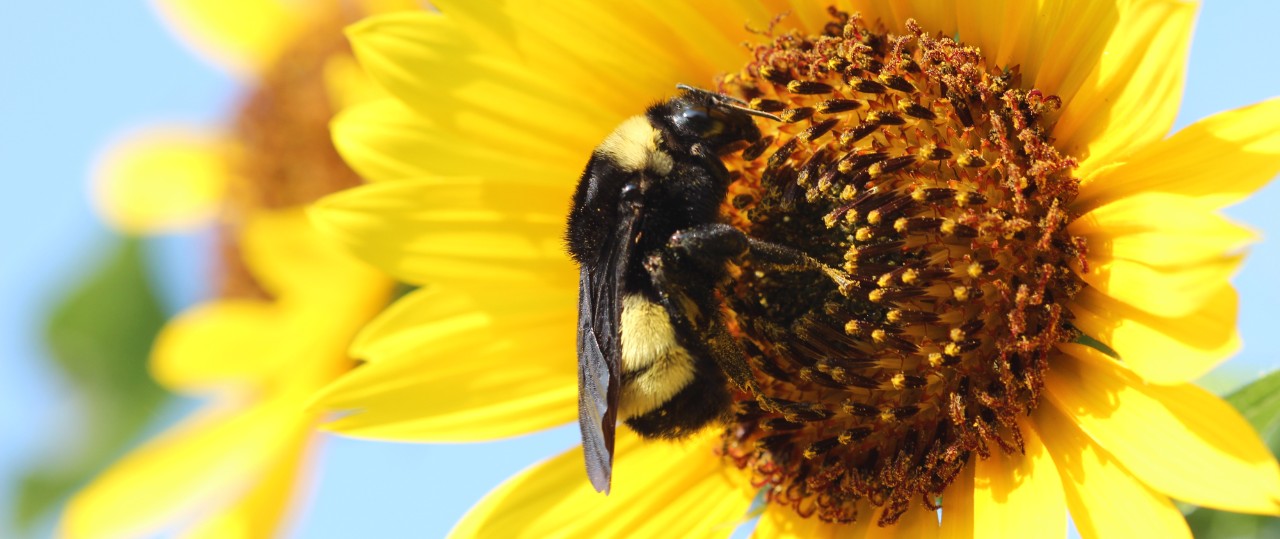
About
Pollinators are essential for both native habitats and agricultural systems. A diversity of pollinators means that a diversity of wild and domesticated plants are able to reproduce. Recent reports of the decline in pollinator populations raises concern for native plant diversity, ecosystem stability, and food production. The loss of pollinators is caused by a combination of several circumstances: habitat loss and fragmentation, pesticide use, increased diseases, invasive species, and climate change.
Most pollinators are attracted to plants because they receive food in the form of nectar or pollen from the flower. Pollinating, or moving pollen from flower to flower, is not directly important to the pollinator. However, movement of pollen helps to mix the genetic material of the plant species. Most flowering species require pollination to grow viable seeds and fruits. Just like the plants in your garden need pollination to produce beans or peppers, native plants need pollination to make sunflower seeds or blackberries. Pollinators help plants maintain genetic diversity and boost reproduction in both native and domesticated plant populations.
The honey bee is the most iconic pollinator on Earth, but it can’t do the work alone. Native pollinators are necessary to pollinate the diversity of our native plants. We need all these little animals – butterflies, wasps, bees, flies, beetles, ants, moths – to help the thousands of plant species that make up our native habitats.
Photographer
Bryan Reynolds generously donated his work for this project
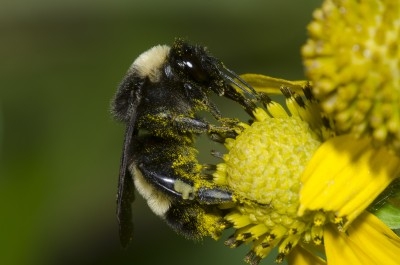
The American Bumble Bee, Bombus pensylvanicus, is one of the most well-known bees. Unfortunately, this beloved bee is seeing a rapid decline in population.Bombus pensylvanicus are broadly distributed across the United States – the range covers the eastern United States and well past the Rocky Mountains, but sightings have dramatically dropped to a smaller area of concentration. The most likely causes for this decline are agricultural development, which threatens their preferred habitats of tallgrassand shallow burrows. Parasitic infection has also been noted as a threat.
This Bumble Bee is an enthusiastic pollinator, frequenting Asters, Thistles, Vetches, St. John’s Wort, and Sunflowers, among many others. Bumble Bees are knownto use their jaws and wings toshake pollen out of flowers in a process called buzz pollination. Some plants keep their pollen in special structures that are not open and must be vibrated to release the pollen through a small pore (fun videos here! http://www.anneleonard.com/buzz-pollination)
American Bumble Bees are a colonial species, meaning they live together in a group working cooperatively. Females can lay eggs without males, which is calledhaplodiploidy, with unfertilized eggs developing into males. Fertilized eggs result either in female workers or Queens. Bees traditionally forage close to home, but have been recorded flying in a 1.5 miles radius around their hives (a location skill established by trial and error).
American Bumble Bees are typically less than 2 centimeters in length. All members of both sexes have black heads, with a black stripe dividing the yellow thorax. The abdomen is primarily yellow, though this varies: The most distinctive features of American Bumble Bees are their heads. They are long, with long tongues and long antennae. The legs are also black, with short hair. Predators are deterred by the American Bumble Bee’s stinger and many species without stingers (such as beetles, moths, and other bee species) mimic the bumble bee to fool predators into thinking they too are dangerous.
For further reading, consult these sources:
http://www.bumblebee.org/NorthAmerica.htm
https://www.fs.fed.us/wildflowers/pollinators/documents/BumbleBeeGuideEast2011.pdf
https://www.nytimes.com/2013/07/11/science/unraveling-the-pollinating-secrets-of-a-bees-buzz.html
Featured pollinator plant: Cutleaf Coneflower Rudbeckia laciniata
Written by: Robert Gibson, an undergraduate Environmental Studies student at the University of Oklahoma
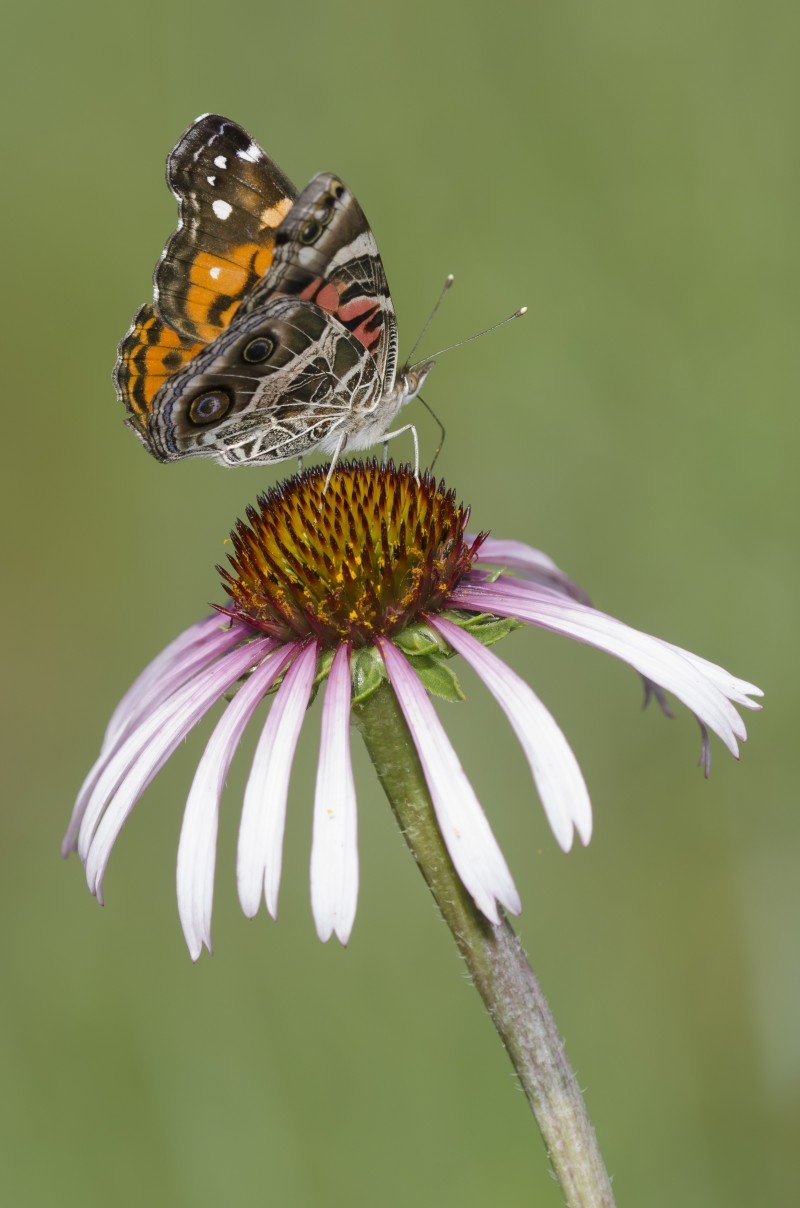
The American Lady Butterfly has distinctive coloration and patterning, with orange wings and black tips, somewhat similar to the Monarch butterfly – but what really sets American Lady Butterflies apart is distinctive eyespots visible on the underside of the wings. There are two large white eyespots, one on each wing, usually the forewing. The forewings are slightly concave, distinguishing it from the Painted Lady, Vanessa cardui, a similar species (which also has four eyespots).
The wingspan of adult American Lady Butterflies ranges between 1.5 – 2.5 inches. The females lay yellow-green eggs on the upper leaf surface of a variety of host plants. Fully-grown larvae are usually one and a half inches in length themselves. These larvae are mostly yellow but some have black markings or stripes fully along their segments. A white band usually traverses the entire length of the larvae. The pupae are less than an inch in length. During metamorphosis, the pupae will assume the typical “J” shape found in this life cycle.
The Vanessa family is characterized by a near-global distribution. Where to spot it depends on the time of year. During the summer, this species may be observed in southern Canada and the northern US (with the exception of the northwest). During the winter, it migratessouth. This variety enjoys the sunshine, with meadows and fields containing its favorite food source: cudweeds, vetch, milkweeds, goldenrod, and pussytoes (among other flowers). Other open environments such as canyons may also house this species. Males can be found on hillsides or in vegetation, when on flat land.
For more information, please consult these sources:
https://www.butterfliesandmoths.org/species/Vanessa-virginiensis
https://www.insectidentification.org/insect-description.asp?identification=American-Lady-Butterfly
Featured pollinator plant: Purple Coneflower Echinacea angustifolia
Written by: Robert Gibson, an undergraduate Environmental Studies student at the University of Oklahoma
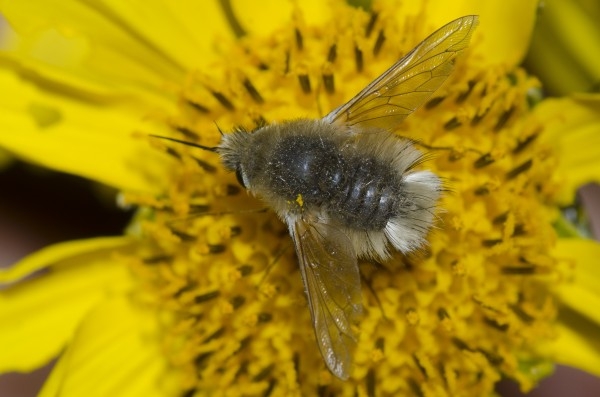
The Barred Bee Fly is a member of the Bombyliidae family, known as humbleflies or beeflies. These members are adept at pollination, since the majority of their diet consists of nectar. While adults frequent flowers, larvae are fed paralyzed insects— therefore, they’re known as parasitoids. Aside from its pollination, this species is prized for its ability to cut down insect populations, such as grasshoppers and caterpillars (using them as food for larvae). However, this family also lays eggs in bee burrows, where its own larvae can feed on the stored pollen of bees.
A variety of morphological features can help the average naturalist identify the family. In length, the smallest recorded specimen was 2 millimeters long, but wingspans of up to 40 millimeters have been found. Another distinguishing feature of bee flies is their tendency to “fold their wings back” in repose. The barred bee fly, true to its name, has an abdomen divided between yellow and black bands, along with a black or dusky thorax, and a black head. All threeof these segments are covered in wiry, dense hair. The eyes of this species have been described as a dull, muted orange. Like other Bombyliidae, the Barred Bee Fly has a proboscis, though their proboscis is straight (a characteristic shared by all bee flies), and cannot be retracted. It’s theorized that bee flies exhibit this unique coloration as a form of batesian mimicry, where a nonlethal species imitates a dangerous species to deter predation.
The largest members of this species are usually found in temperate climate zones, but they are common in the tropics. As a rule, barred bee flies enjoy open, sunny environments so they may find nectar and prey.
For more information see teh following:
https://www.britannica.com/animal/bee-fly
https://davesgarden.com/guides/bf/go/7133/#b
https://www.fs.fed.us/wildflowers/pollinators/pollinator-of-the-month/bee_flies.shtml
https://seeds.ca/pollination/pollinator-profiles/flies/bee-flies
Featured pollinator plant: Blue Mistflower Conoclinium coelestinum
Written by: Robert Gibson, an undergraduate Environmental Studies student at the University of Oklahoma
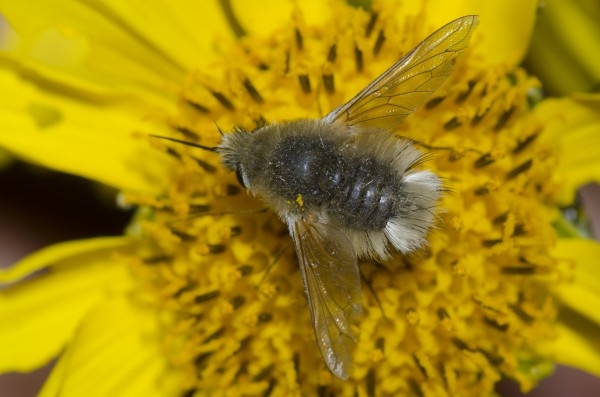
Flies from the Bombyliidae family are found throughout the northern hemisphere, such as in North America, Europe, and Asia, and are found in cosmopolitan or arid environments. This family of flies imitates bees, bumblebees in particular as that is how they got their common and scientific name. Bee flies are stout, brown, fuzzy, buzz when they fly, and their bodies are between 4mm and 40mm long. Those are some traits similar to bumblebees, however some differentiating traits are their two wings, large eyes, skinny long legs, and very short antennae.
Their flying capabilities reflect hovering, agility, and fast maneuvering, where they can change directions quickly or dart away. To get nectar they use their proboscis, a stiff and long tongue, while hovering next to the flower. Hovering helps them avoid predators that may be hiding in the flowers. The pollen is transported by sticking to their furry coat and falls off at other flowers. Some flowers that they visit in the early spring are Claytonia virginicas and act just as efficiently at pollinating them as bees do.
While hovering, the bee fly will look for bee nests to lay eggs in. This is a parasitic relationship where the newly hatched larvae will find their way to the chamber where the bees lay their eggs, and eat all of the stored pollen, as well as the bee larvae. Once grown, it will pupate and stay in the nest until Spring comes around once more.
For more information check out the following websites:
https://www.amentsoc.org/insects/glossary/terms/bee-fly
https://bugguide.net/node/view/185
https://www.fs.fed.us/wildflowers/pollinators/pollinator-of-the-month/bee_flies.shtml
Oklahoma Native pollinator plant: Golden Crownbeard Verbesina encelioides
Written by: Christian Newkirk, an undergraduate Environmental Science student at the University of Oklahoma
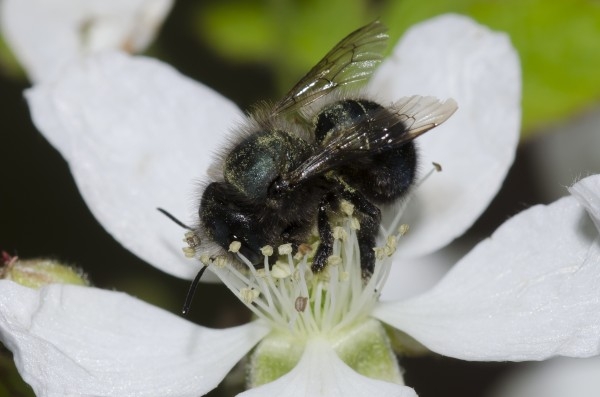
The Blue Orchard Bee, Osmia lignaria, is a distinctive species. Opposed to the typical black-and-yellow coloring of a steriotypical bee, these bees are blue-black in appearance. Manyshow a shimmering blue. Because of their metallic appearance, Blue Orchard Bees can be mistakenly identified as sweat bees (the Halictidae family).
Blue Orchard Bees are unique in other ways besides appearance. While the eggs and larvae are almost indistinguishable from those of Honey Bees, Blue Orchard Bees nest individually, unlike the Honey Bees’ preference for colonial hives. Female bees do most of the work in this regard. Each finds a mate and proceeds to make a nest. They prefer to make nests in pre-existing structures. Blue Orchard Bees can’t bore through wood, like carpenter bees, or use leaves to build structures, unlike Leaf Cutter Bees. Osmia Lignaria’s medium of choice is mud. Inside the nest, the female creates partitions and cubbies for each egg, laying upto 5. Pollen and nectar are also included with the eggs. Even though they prefer to be solitary, Blue Orchard Bees usually don’t attack each other, or humans, for that matter. Males are smaller than females, measuring roughly 1 centimeter in length, compared to the average 1.5 centimeter females. Males can be distinguished by their longer antennae.
Blue Orchard Bees are widely distributed across the continental United States, which arebroken up into two subspecies divided by the Rocky Mountains. The bee’s presence is highly desirable for farmers — Blue Orchard Bees are so named because they excel at pollinating orchard trees, such as almond, apple, pear, and cherry. The Blue Orchard Bee carries pollen onits back abdomen, instead of its legs, spreading more pollen than Honey Bees. To encourage their presence, farmers construct “bee houses” (like bird houses), with pre-constructed individual tunnels (make your own bee house! https://www.nwf.org/Garden-for-Wildlife/Young/Build-a-Bee-House).
For more, please read the following sources:
http://entnemdept.ufl.edu/Creatures/MISC/BEES/blue_orchard_bee.htm
https://www.fs.fed.us/wildflowers/pollinators/pollinator-of-the-month/mason_bees.shtml
https://modernfarmer.com/2017/04/meet-north-americas-native-pollinator-blue-orchard-bee/
Oklahoma native plant: Blackberry Rubus allegheniensis
Written by: Robert Gibson, an undergraduate Environmental Studies student at the University of Oklahoma
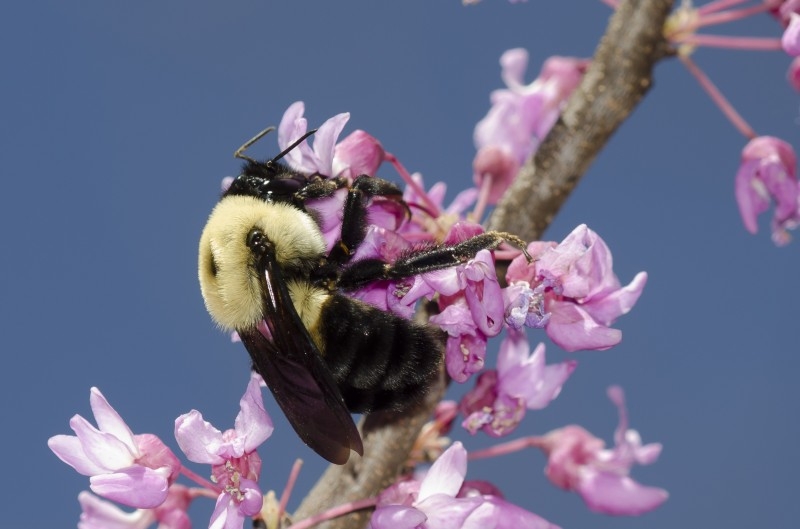
Bombus griseocollis are most common in the eastern US, though they range across North America. Brown-belted Bumble Bees are visible from May to October, while they feast on a nectar diet from plants such as milkweeds, sunflowers, coneflowers, and sumacs. These flower sizes all make nectar available to this bumble bee’s medium-length tongue. The Queens of this species are picky however, demonstrating a fondness for Legumes (plants in the bean family).
Nests for this species can be found on the ground or just below the surface and are usually populated by 50 or fewer bees. Prime real estate for Brown-belted Bumble Bees isn’t confined to one particular habitat type — nests have been found in forests, wetlands, prairies, and human-inhabited areas, both in farmland and in cities. As far as conservation goes, this species has no shown significant declines and we are likely to continute to see them flying through the meadows and dawdling through the summer skies.
The Brown-belted Bumble Bee, Bombus griseocollis, is characterized by yellow hair covering the head and thorax, with black fur indicating the abdomen. A black spot can often be seen between the wing bases. This pattern is broken by a brown band of hair on the second segment of the abdomen, surrounding by the usual patch of black hair. The band is a light shade of brown, like a streak of dried dirt. The Queens of this species are typically bigger than the workers – 2 to 2.5 cm long compared to 1.5 cm in length. Both have black heads and legs, with large eyes.
Useful resources to discover more about the Brown-belted Bumble Bee include:
https://www.fs.fed.us/wildflowers/pollinators/documents/BumbleBeeGuideEast2011.pdf
https://www.fws.gov/midwest/endangered/insects/rpbb/rpbbid.html
https://www.inaturalist.org/taxa/120215-Bombus-griseocollis
Featured pollinator plant: Eastern Redbud Cercis canadensis
Written by: Robert Gibson, an undergraduate Environmental Studies student at the University of Oklahoma
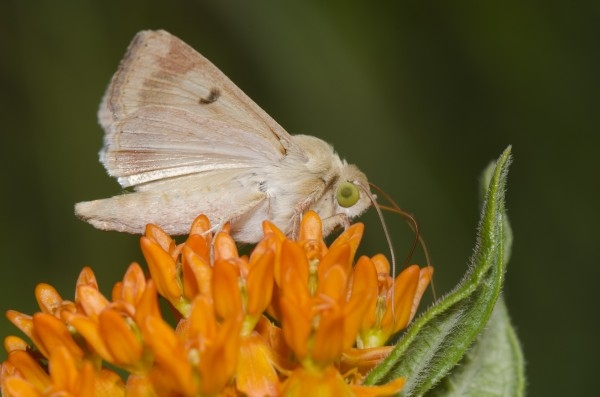
The larvae of the corn earworm come in different colors, ranging from light green to pink to dark brown or black. Light and dark stripes alternate down the body. Tubercles are present with two or three large hairs each. There are five growth stages and end up at 1½ inches long at maturity.
Their eggs are laid singly on the preferred food plant leaves, such as fresh-silking corn, and occurs 3 days after emergence. The eggs are ribbed, hemispherical, and less than 1/16 inch in diameter. After 24 hours, the eggs develop a red ring around their white exterior and will show the black head capsule just before hatching. Each egg will take 3 to 4 days to hatch. Newly hatched larvae will feed on the host plant, typically the reproductive structures. These larvae are not initially cannibalistic, however will grow to become more aggressive and kill other larvae over time. The pupa are about ¾ to 1 inch in length and are reddish or light brown. They call soil home near the host plant and can be as deep as 6 inches. Pupal stage is about 13 days. Adults are nocturnal moths that are about ¾ inch long with a wingspan of 1½ inches. Dark lines or spots decorate the tips of the yellowish tan forewings. The hindwings are whitish with dark grey veins and border.
During daylight, the moths may hide in vegetation or feed on nectar. A healthy female can lay between 500 to 3000 eggs, and can produce up to 35 per day. They have several broods from May to December and can be found throughout North America except for Canada and Alaska. The corn earworm does not overwinter successfully in the north-eastern United States. It is most active in tropical and subtropical climates. Their life cycle can be completed in as little as 30 days.
For more information check out the following websites:
https://ipm.illinois.edu/fieldcrops/insects/corn_earworm.pdf
https://www.butterfliesandmoths.org/species/Helicoverpa-zea
http://entnemdept.ufl.edu/creatures/veg/corn_earworm.htm
Featured pollinator plant: Butterflyweed Asclepias tuberosa
Written by: Christian Newkirk, an undergraduate Environmental Science student at the University of Oklahoma
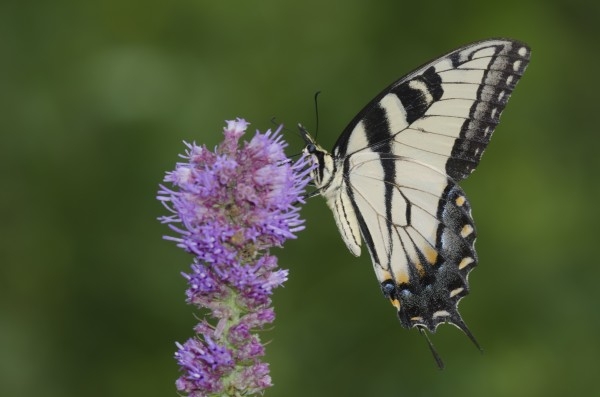
The eastern tiger swallowtail butterfly has different features based on gender. Males are yellow with dark tiger stripes, while the female can be yellow or black with shadowed stripes. The upperside hindwing has an orange spot and the underside of the forewing may have a band of color similar to the Canadian tiger swallowtail. The average wingspan varies between 2.5 to 4.5 inches for both male and female. This makes them much larger than a monarch.
Throughout the year there are two broods from May to September in the north and three broods from February to November in the south. When mating, the males actively patrol in search of a mate. Eggs are laid singly on host plants. Once hatched, the caterpillars feed on the leaves of the host plant, such as wild cherry, sweetbay, basswood, tulip trees, and willows. Caterpillars are brown and white in color when newly hatched but change color to green with orange and black false eyespots as it grows older. As an adult they will feed on the nectar from lilac, wild cherry, milkweed, and joe-pye weed to name a few.
Eastern tiger swallowtail can be found from eastern North America in the Rocky Mountains down to central Texas. This species likes deciduous habitats such as broadleaf wood, forest edge, river valleys, parks, and even suburbs. Generally, they can be found alone, with males flying and looking for a mate.
Useful resources to discover more about the Eastern Tiger Swallowtail include:
https://www.naba.org/chapters/nabanj/butterflies/eastern_tiger_swallowtail.html
http://www.nhptv.org/natureworks/easterntiger.htm
https://www.butterfliesandmoths.org/species/Papilio-glaucus
Featured pollinator plant: Texas Blazing Star Liatris punctata var. mucronata
Written by: Christian Newkirk, an undergraduate Environmental Science student at the University of Oklahoma
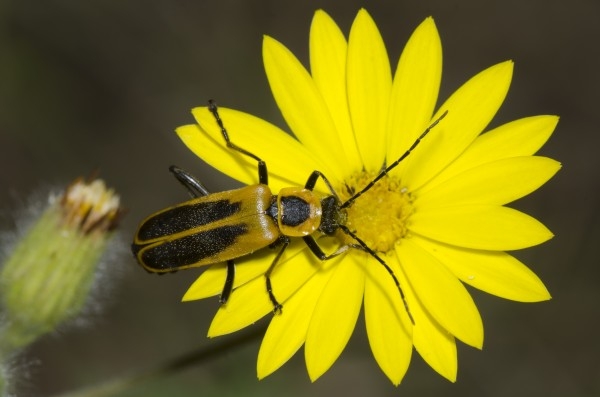
Goldenrod Soldier Beetles have soft, flexible elytra (wing covers) and resemble fireflies, but do not have light-producing organs. This species is very common in the Midwest and are 12mm long, orange beetles, with two prominent brown-black spots on the elytra. Goldenrod flowers are where they are commonly seen, but they also visit other flowers, including yellow composites, Queen Anne’s lace (Daucus carota), milkweed, rattlesnake master (Eryngium yuccifolium) and other late-summer flowering plants. These flowers are a meeting place to find a mate. No damage is done to the plant, and they o not bite or sting.
Eggs are laid in clusters in soil. The larvae are dark, long, slender, and covered in tiny dense bristles, giving a velvety appearance. Once hatched, they remain in the soil where they can prey on grasshopper eggs, small caterpillars and other soft-bodied insects.
The adults are out from July to September, being most abundant in August. They make their home in fields, gardens, and meadows, where they primarily feed on the pollen and nectar of flowers, but also eat small insects, such as caterpillars, eggs and aphids. Moist soil in meadows and fields makes a great home for them.
For more information check out the following websites:
https://ninnescahlife.wichita.edu/node/409
https://blogs.k-state.edu/kansasbugs/2015/09/11/be-on-the-look-out-for-goldenrod-soldier-beetles/
https://wimastergardener.org/article/goldenrod-soldier-beetle/
Featured pollinator plant: Soft Goldenaster Bradburia pilosa
Written by: Christian Newkirk, an undergraduate Environmental Science student at the University of Oklahoma
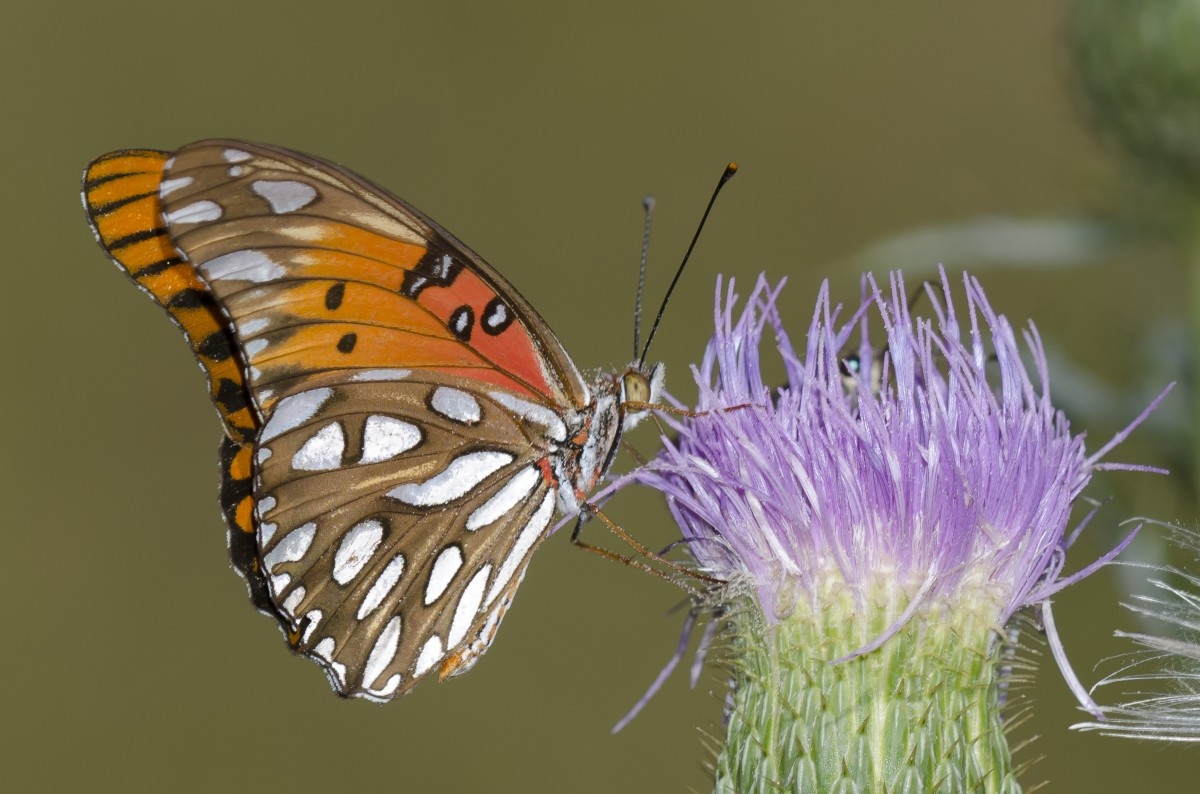
This beautiful pollinator has bright colors and is found in the extremely southern portions of the United States and Mexico. Their coloring is orange with black markings and white spots that warn predators to stay away. This particular species of butterfly is native to the southeastern United States and eastern Mexico, where they thrive in environments from open sunny pastures, to roadsides and parks.
Every year multiple generations of Gulf fritillary are born and travel northward in the spring to form breeding colonies in the southeast. Large numbers of the adult Gulf Frillary continue to migrate toward Florida, overwintering in frost-free portions of their range. The quick and erratic flight of adults do not hinder their attraction to flowers. Their wingspan is 2.5 to 3.75 inches, though females are larger than males. The males actively search for females to mate with around passionflowers.
Their small yellow eggs are laid on parts of passionflower plants. Passionflowers are not usually eaten by insects, as they produce toxins to most insects. The Gulf fritillary, however, is adapted to ignore these defenses. The bright orange larvae feed on all parts of the plant, rapidly defoliating the host vine, and develop into a pupa that is a mottled brown. Adults overwinter in the south. They also often stay in open pastures and fields. Their flight paths are generally above the reach of humans and they fly fast.
Useful resources to discover more about the Gulf fritillary include:
http://entnemdept.ufl.edu/creatures/bfly/gulf_fritillary.htm
https://www.butterfliesandmoths.org/species/Agraulis-vanillae
http://bugoftheweek.com/blog/2015/2/23/beautiful-but-stinky-gulf-fritillary-iagraulis-vanillaei
https://www.insectidentification.org/insect-description.asp?identification=Gulf-Fritillary-Butterfly
Featured pollinator plant: Tall Thistle Cirsium altissimum
Written by: Christian Newkik, an undergraduate Environmental Science student at the University of Oklahoma
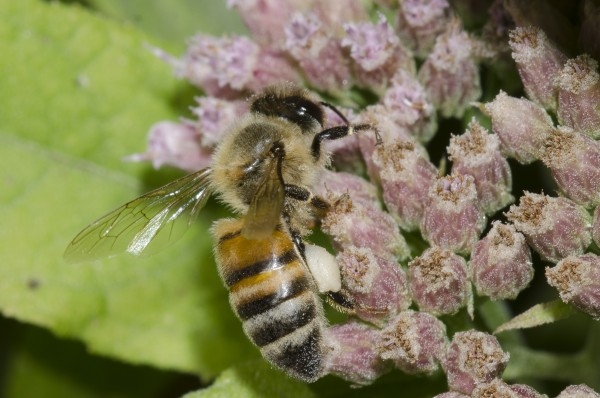
Honey Bees! Everyone loves them! Everyone knows at least something about them. Yet this species (Apis mellifera) can still surprise you. This species, also known as the Western or European honey bee, is distributed across most of the globe, with the exceptions of northern Africa and Asia. Such a broad distribution implies a massive amount of branching out into varying subspecies – with 32 different subspecies of Honey Bee worldwide. This species most closely resembles the stereotypical appearance of a bee, with yellow fuzz covering the head and thorax segments, which have black skin underneath. The eyes, antennae, and legs are black as well, with the abdomen being broken up by black-and-yellow stripes. These eyes have been described as hairier than those of other bee species.
Honey bees exhibit eusocial colony building behavior, similar to how they are depicted inmost media. This is organized into the usual castes of female workers, male drones, and the Queen (all present at separate points of the hive cycle). A hive population fluctuates between 40,000 and 80,000 bees. Worker bees are typically 1 to 1.5 centimeters in length; drones are longer, maxing out at 2 cm; and Queens are larger still, ranging from 2 to 3 cm. The familiar image of the honeycomb is certainly present with this species. Larvae are sealed within the individual wax combs to transform into their pupal stage, with other combs devoted to honey storage. Honey bees frequent a wide array of flowers for pollination, an activity that makes themprized agricultural workers. Apples, cherries, melons, almonds, and blueberries are just some ofthe plants dependent on honeybees. A distinctive feature of this species is the “pollen basket”. The pollen basket doesn’t refer to the many crops pollinated by honey bees, and it’s not an adorable tournament where honey bees compete against each other. The pollen basket is a clump of hair on several species of bees’ hind legs. If you’ve ever seen a bee with a yellow mass on their hind legs, this is the pollen that they gather in the basket. The pollen is held together with nectar and packed on by bees when they groom themselves.
Unfortunately, honey bees have been exhibiting signs of a disturbing decline. Colony Collapse Disorder is a phenomena that has affected between 30-50% of hives in the late 2000’scharacterized by a mass exodus of worker bees from a colony, even when the colony had ample honey and pollen. The reason for this is unclear, but stress from agricultural intensification is a likely culprit. Bees are victims of stress from unsafe handling practices or being placed in constant close proximity to human habitation. Naturally, this is a worrying trend, given the importance of honey bees in agriculture. This has sparked a renewed interest in beekeeping.
For more, consider these sources:
https://bugguide.net/node/view/3080
https://entnemdept.ifas.ufl.edu/creatures/MISC/BEES/euro_honey_bee.htm
Written by: Robert Gibson, an undergraduate Environmental Studies student at the University of Oklahoma
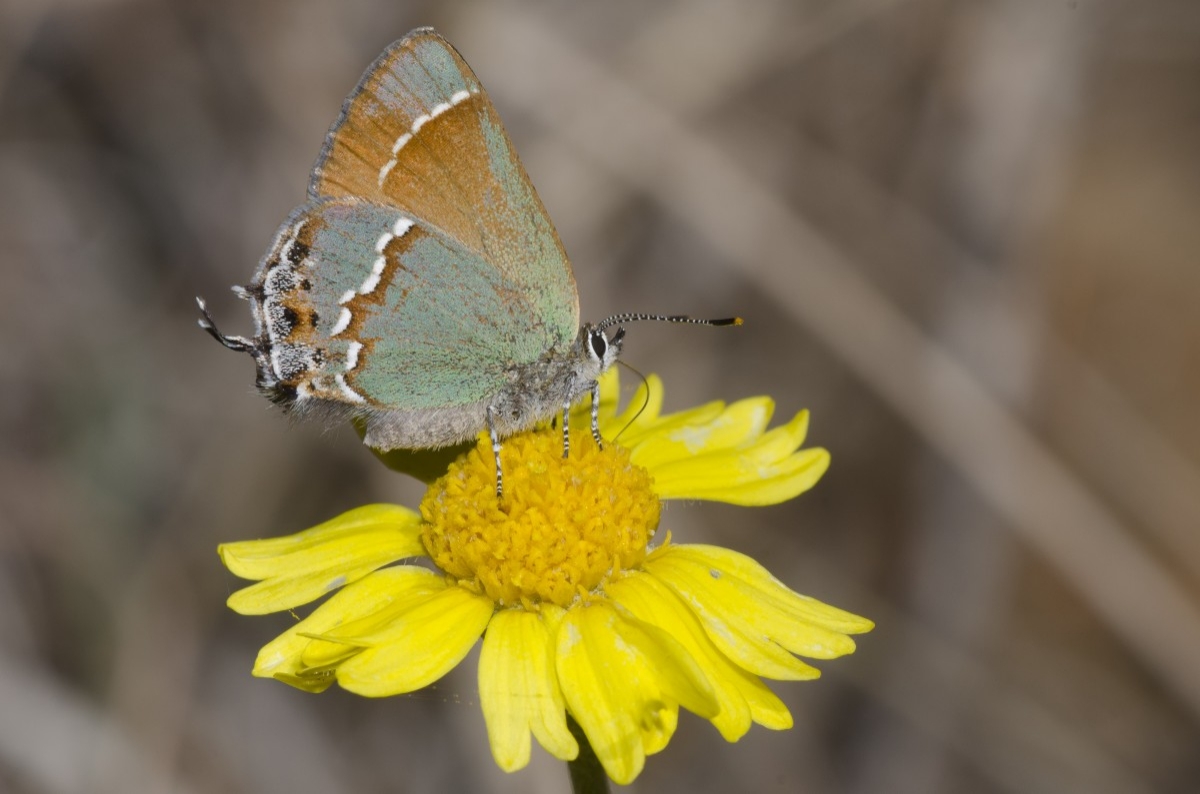
The Juniper Hairstreak, also known as the Olive Hairstreak or Olive Juniper Hairstreak, is a small butterfly that has an apple-green underside in eastern Canada. The western subspecies has a more yellow green coloring. At the base of the green hindwings are two white marks along a reddish-brown inward line. A typical Juniper Hairspray has a wingspan of about 0.75″ – 1.25″.
Early on in development the larva has white or yellow markings along each side of its green and bumpy body. Each stage is roughly a week and the butterfly itself can live up to ten days. The egg stage is 4-6 days, the Caterpillar (larval) stage 3-4 weeks, the Chrysalis (pupal) stage 10-20 days, and the Adult butterfly stage 4-10 days. It overwinters as a chrysalis. There is a single brood in May-August, and another from March-July in the west.
Juniper Hairstreaks have a wide range across the continental United States, however is only located in a few areas of Canada. Generally, it feeds on Eastern Red Cedar or junipers. The Juniper Hairspray can be found near their foodplants on dry hillsides on mid-sized trees. To find this butterfly, one only need to shake a Juniper tree to disturb it. When a male is in search of a mate, he perches on host trees during the day. The leaves that the eggs are laid on provide food for the caterpillars. The adults feed on nectar from plants, such as the winter cress, dogbane, common milkweed, wild carrot, shepherd’s needle, butterflyweed, white sweet clover, and others.
The Juniper Hairstreak Butterfly (Callophrys gryneus) has The Nature Conservancy Global Rank of G5, meaning that while it is secure in most regions, it may be rare in the periphery of its range.
Useful resources to discover more about the Juniper Hairstreak Butterfly include:
https://www.butterfliesandmoths.org/species/Callophrys-gryneus
https://www.butterfliesathome.com/juniper-hairstreak-butterfly.htm
http://www.cbif.gc.ca/eng/species-bank/butterflies-of-canada/juniper-hairstreak/?id=1370403265660
Featured pollinator plant: Stemmy Four-nerve Daisy Tetraneuris scaposa
Written by: Christian Newkirk, an undergraduate Environmental Science student at the University of Oklahoma
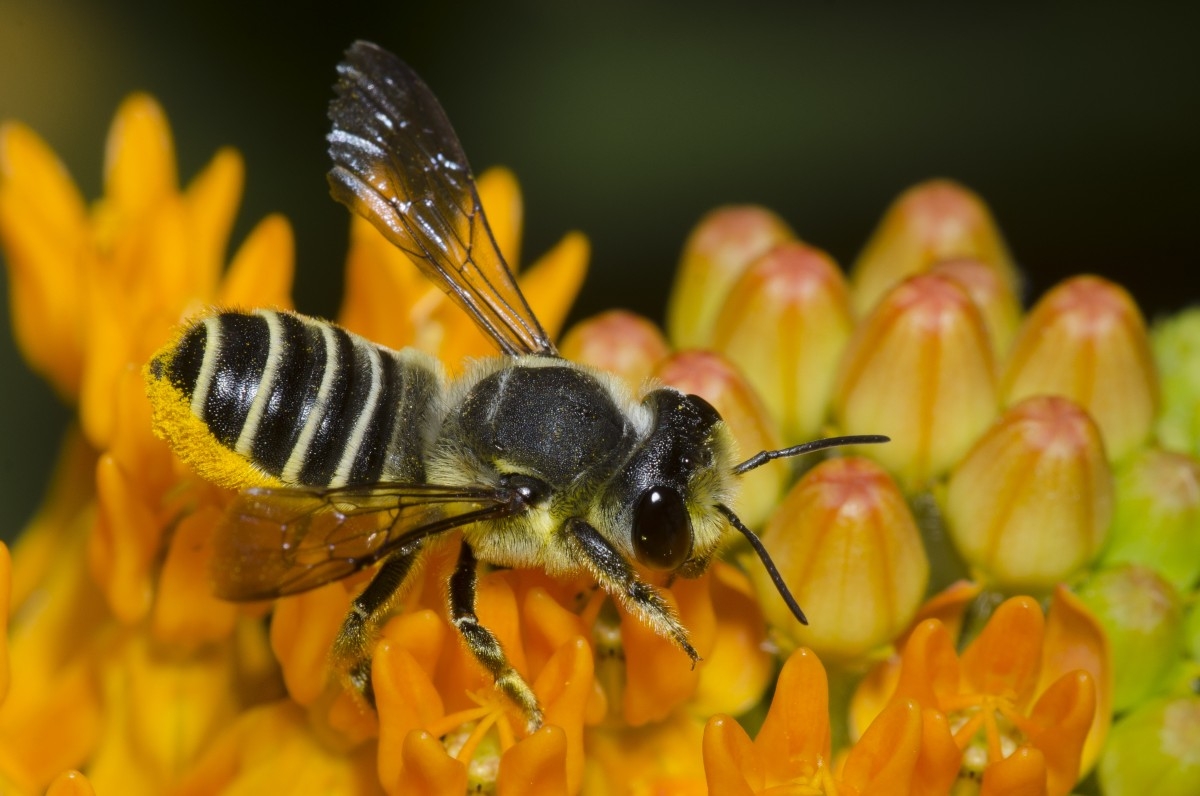
Megachilidae is a family of bees, more commonly known as Leafcutter bees. Some genera within this family are known as mason bees and others wool-carder bees. These common names refer to their habit of constructing burrows, with mud and plant resin (mason), with pieces of leaves (leaf-cutter), plant-hairs (wool-carder). This family of bees is widely distributed across North America.
Leaf-cutters are morphologically distinct from the usual run of bees, thicker than most species and predominantly black. Some abdomens are completely back, yet others are are patterned with yellow patches or stripes. Female Leaf-cutter bees carry pollen on the underside of their abdomen, using hairs called scopa (a trait that distingusihes Megachiles), and this is why Leaf-cutters often appear to have gold underbellies when photographed. This family ranges in size from half a centimeter long to 2.5 centimeters long. Their wing tips are black, along with their antennae.
Leaf-cutter bees are gentle bees, typically, they will only leave a slight sting if handled. They often come into closer contact with humans than most pollinators, because of their habits of leaving holes in garden plants to build their nests. That’s right, nests! A common myth is that they eat leaves – definitely not! Nest structures are usually made in pre-existing cavities and are modified with mud, resin, and leaf fragments.
Megachilidae family are considered solitary bees and do not form hives or colonies. Female bees look for a mate in spring and summer (these bees are visible between March and October). After fertilization, the female stores eggs in individual cubbies within a nest. You can think of each female as a solitary Queen. Each egg is given nutrition and sealed away until it hatches. The males don’t have to live under monarchical rule, though. Males die almost immediately after fertilizing the eggs.
Useful resources to discover more about leaf-cutter Bees include
https://entomology.ifas.ufl.edu/creatures/misc/bees/leafcutting_bees.htm
Featured pollinator plant: Butterflyweed Asclepias tuberosa
Written by: Robert Gibson, an undergraduate Environmental Studies student at the University of Oklahoma

Black with yellow stripes, or yellow with black stripes? For Megacyllene robiniae, this question remains wholly unanswered. The Locust Borer is a relatively small parasitic beetle stretching to about three-quarters of an inch, but this elongated body packs an extremely conspicuous color scheme. The adults of this species are identified through their long black antennae, reddish legs, and their conspicuous patterns of yellow and black spanning the length of the body. The yellow bands take the rough shape of a “W” which further aids in identification of this beetle. The grubs of this species are less spectacularly colored, like many grubs they are observed to have a dark round head and body segments that give them a lumpy appearance. The pupae of this species look like yellow mummies, with adult features clearly visible. The unique trait of this species is that the grubs find a sole host in the Robinia pseudoacacia L., the black locust tree. As a result of this exclusive parasitic relationship, the Locust Borer finds it’s range coinciding with where its host tree andornamental cultivars are cultivated, specifically across the Eastern United States, spanning from West Virginia to the southeast corner of Oklahoma. Infection of a black locust tree begins when the adult beetle lays its eggs on the rough bark of thetree, followed by the grub eating its way into the tree. Repeated infection often causes the tree to structurally weaken, and this is exacerbated by extended droughtand poor soil which simultaneously increases Locust Borer activity.
The adults of this species are an important pollinator. Although the grubs feed on the trunk and branches of the Black Locust tree, the adults feed on plant pollen. TheLocust Borer has a preference for pollen of goldenrod, but has been known to feed on other flower pollen when goldenrod is unavailable.
As a pollinator, this species is very helpful to the native flower populations of the regions it inhabits. This beetle does not suffer extensive predation from the species native to its environment, and as a result it is often found among undeveloped fieldsfreely eating and pollinating.
Some additional resources for the Locust Borer Beetle are as follows:
http://entoweb.okstate.edu/ddd/insects/locustborer.htm
https://bugguide.net/node/view/436
https://www.pubs.ext.vt.edu/content/dam/pubs_ext_vt_edu/ENTO/ENTO-141/ENTO-141-pdf.pdf
https://digitalcommons.usu.edu/cgi/viewcontent.cgi?referer=
Featured pollinator plant: Rubber Rabbitbrush Ericameria nauseosa
Written by: Joshua Hughes, an undergraduate Aerospace Engineering student at the University of Oklahoma
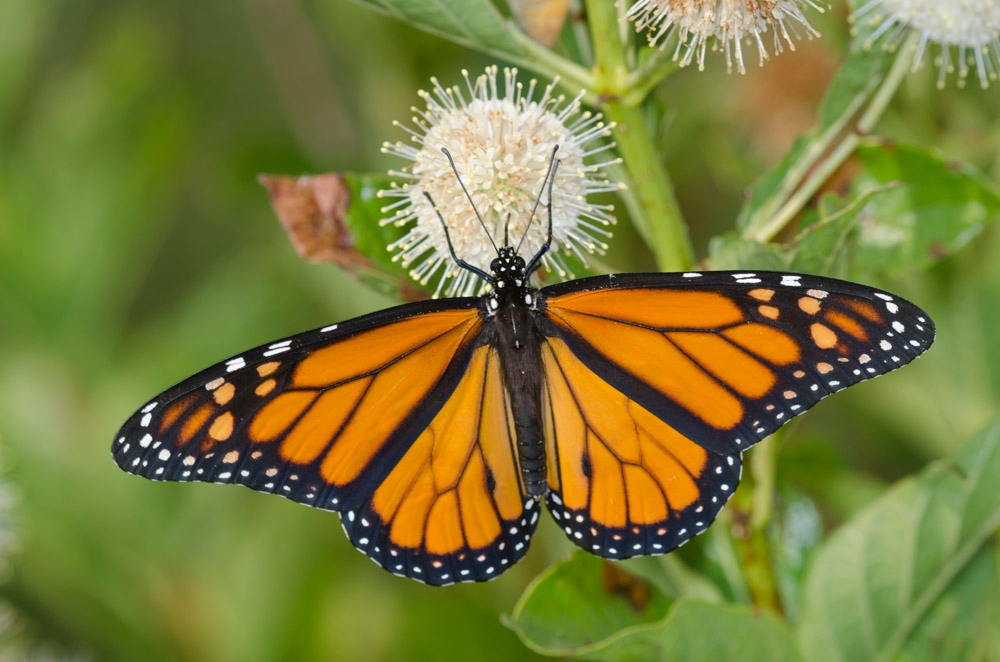
In addition to being a beautiful creature that many admire, the Monarch butterfly is a complex and resilient invertebrate, as well as an important pollinator. The species resides mostly in North America, easily recognizable by its bright orange, black, and white wings and white-spotted body. The Monarch begins its life as a very small egg usually found on the underside of a milkweed leaf. The egg hatches into a vibrant black and yellow-striped caterpillar that feeds exclusively on the milkweed leaves as it grows through five different stages called instars. Once it reaches the fifth instar, the caterpillar attaches its hind feet to something solid that it can hang from as it creates a chrysalis, or a hard skin that encases the caterpillar as it goes through metamorphosis. Over the course of 10-14 days, the caterpillar’s body turns into a rich liquid full of enzymes that eventually form into the organs, body, and wings of an adult Monarch butterfly. The butterfly emerges with wet, wrinkled wings that it must pump and dry for a few hours before it is able to fly.
The first three generations of adult Monarchs will live relatively close to where they hatched as caterpillars for 4-5 weeks in June and July, staying mostly in the Northern United states and Southern Canada. Once it starts to cool in August and September, the fourth generation will begin a journey south, flying up to 3000 miles to reach warmer conditions in Mexico and Southern California, where they will wait out the winter. The Monarchs that “overwinter” here in the south can live for up to eight months, 7-8 times the lifespan of their ancestors. On their journey north in the spring and south in the winter, monarchs feed on flowers that provide rich nectar to fuel their flights, helping pollinate somewhat accidentally during the process. Despite their crucial role and miraculous life cycle, Monarchs are facing threats of extinction due to logging at overwintering sites, habitat loss, climate change and other factors.
Useful resources to discover more about the monarch life cycle, their incredible migration, and how to protect them include:
https://journeynorth.org/monarchs
https://www.nwf.org/Educational-Resources/Wildlife-Guide/Invertebrates/Monarch-Butterfly
http://help.monarchwatch.org/kb/
http://www.okiesformonarchs.org/
Written by: Kayleigh Clement, an undergraduate Environmental Studies student at the University of Oklahoma
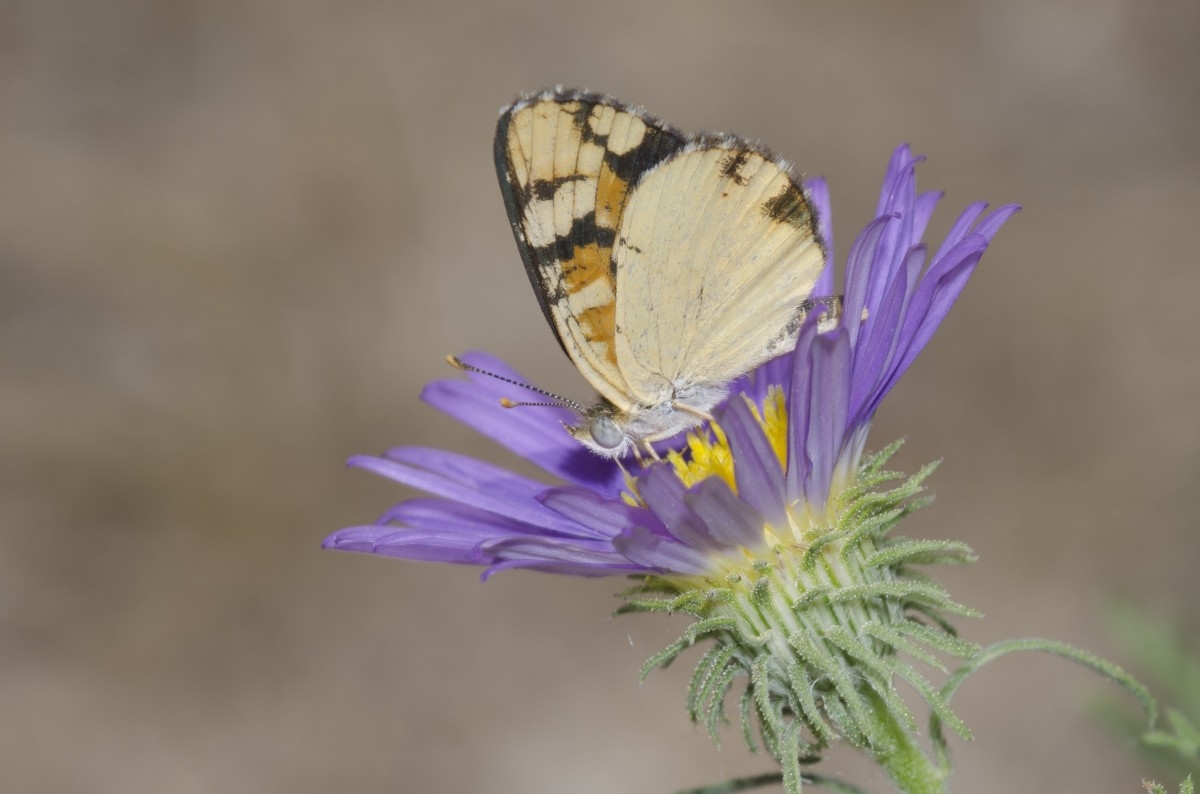
Painted Crescents are dark with yellow spots on their underside and have pale markings on their yellow-cream hindwings. Their wingspan can reach up to 1.5 inches or as little as 1 inch on average. It is very similar to the Phaon Crescent, except for the plain rear wing underside and the dorsal forewing patterns.
There are two to three broods that take place between April and October each year. They will feed on flower nectar from plants such as field bindweed, aster, and hairy tubetongue. Males will actively patrol for mating. The females lay their eggs in clusters on the underside of the host plants. Hibernation occurs during the third stage of caterillars.
Adults will live anywhere from Colorado and Kansas down to northern parts of Mexico. More specifically they can be found in marches, fields, roadsides, and fencerows.
Useful resources to discover more about the Painted Crescent include:
https://www.butterfliesandmoths.org/species/Phyciodes-picta
Featured pollinator plant: Tahoka Daisy Machaeranthera tanacetifolia
Written by: Christian Newkirk, an undergraduate Environmental Scienec student at the University of Oklahoma
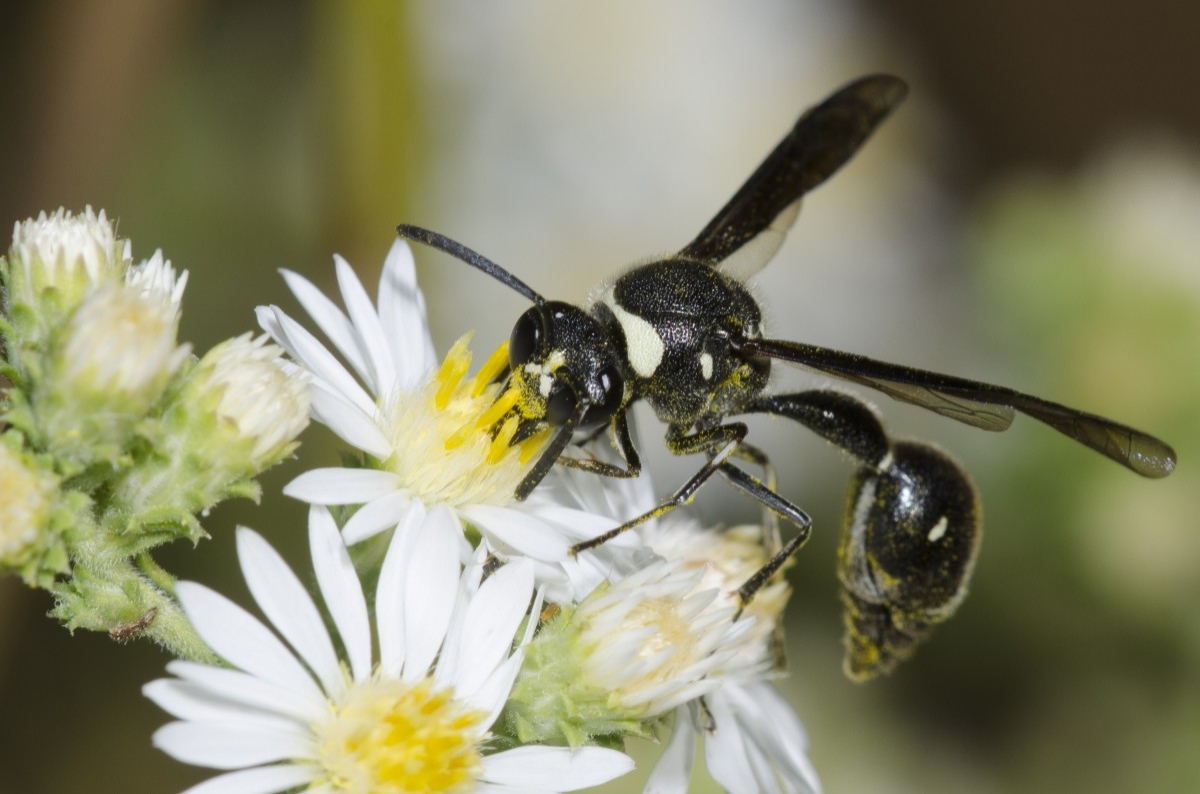
Potter wasps are a subfamily of wasps that encompasses an estimated 3,000 species, but less than 300 are found in North America. In addition to being pollinators, this beneficial group of wasps reduce populations of other insects that would otherwise damage plants.
Like other species of wasp, particularly mud daubers, these wasps will build nesting cellsfor their eggs and larvae. In the Potter wasp group, these burrows are also known as “mud pots.” Sometimes they will also take advantage of pre-existing cavities as homes. Paralyzed prey are brought into these burrows to be consumed by the growing larvae which may consumeup to 12 caterpillars (a staple food) during their maturation.
Like thread-waisted wasps, potter wasps have a thin “waist” breaking up their thorax andabdomen. Adults themselves consume nectar, and are most commonly observed from June to October, frequenting flowers.
For more information, please consult these sources:
https://aggie-horticulture.tamu.edu/galveston/beneficials/beneficial-30_potter_wasp_eumenes.htm
https://entnemdept.ifas.ufl.edu/creatures/misc/wasps/potter_wasps.htm
https://texasinsects.tamu.edu/potter-wasps/
Featured pollinator plant: Heath Aster Symphyotrichum ericoides
Written by: Robert Gibson, an undergraduate Environmental Studies student at the University of Oklahoma
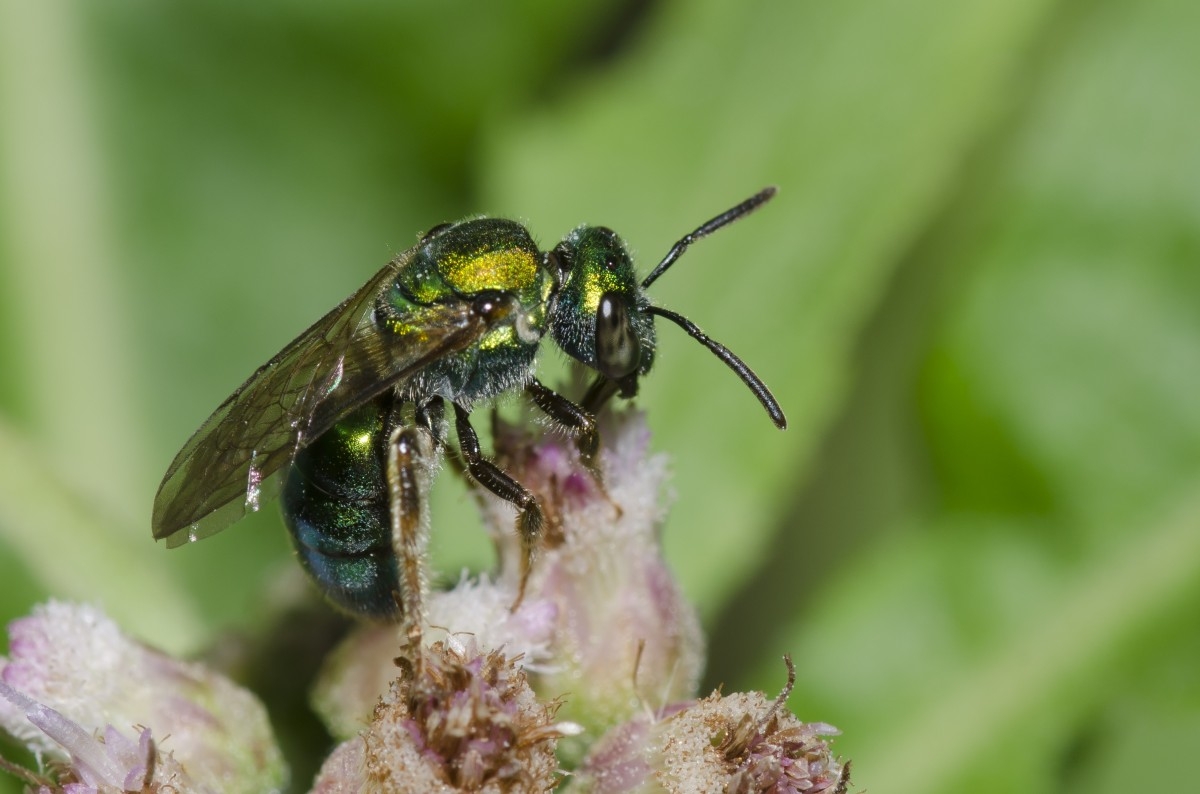
Augochlora pura is a “solitary” bee species, eschewing the colony lifestyle that we normally associate with bees, in favor of a more individualistic existence. Sweat beesare territorial and will attack each other over nesting space—mothers have attacked theiryoung and males will attack other males if they enter inhabited nests. Nests can be found in vacant insect burrows or rotted wood. Augochlora constructs cells, arranged in rows or clusters, within the nests to store their fertilized eggs. Females watch over the cells to reduce predation by birds and ants.
Pure Green Augochlora Sweat Bees can be observed from April to October pollinating a wide variety of plants, which includes milkweeds, verbena, coneflowers, andspiderworts. Sweat bees often mate while situated on these plants— males search for females that are visiting flowers. Augochlora bees monitor their flowers as vigilantly as they monitor their nests, often being observed on a routine patrol of their flowers.
Augochlora do not have the stereotypical yellow and black bee coloration, but is a “metallic” bee. “Sweat” and “metallic” are both informal classes of bees, but most sweat bees have a glimmering, metallic appearance, and are named sweat bees for their presence around perspiration. Perspiring humans have often reported visits by metallic bees, licking and drinking their sweat!
Along with its unique metallic body color, Augochlora bees have black eyes, limbs, and antennae. Females can be identified by pollen-collecting hairs on their legs, and, in some cases, female stingers visibly protrude from their abdomen
Useful resources to discover more about the Pure Gold-Green Sweat Bee include:
https://entnemdept.ifas.ufl.edu/creatures/MISC/BEES/Augochlora_pura.html
https://www.fs.fed.us/wildflowers/pollinators/pollinator-of-the-month/augochlora_pura.shtml
Featured pollinator plant: Marsh Fleabane Pluchea odorata
Written by: Robert Gibson, an undergraduate Environmental Studies student at the University of Oklahoma
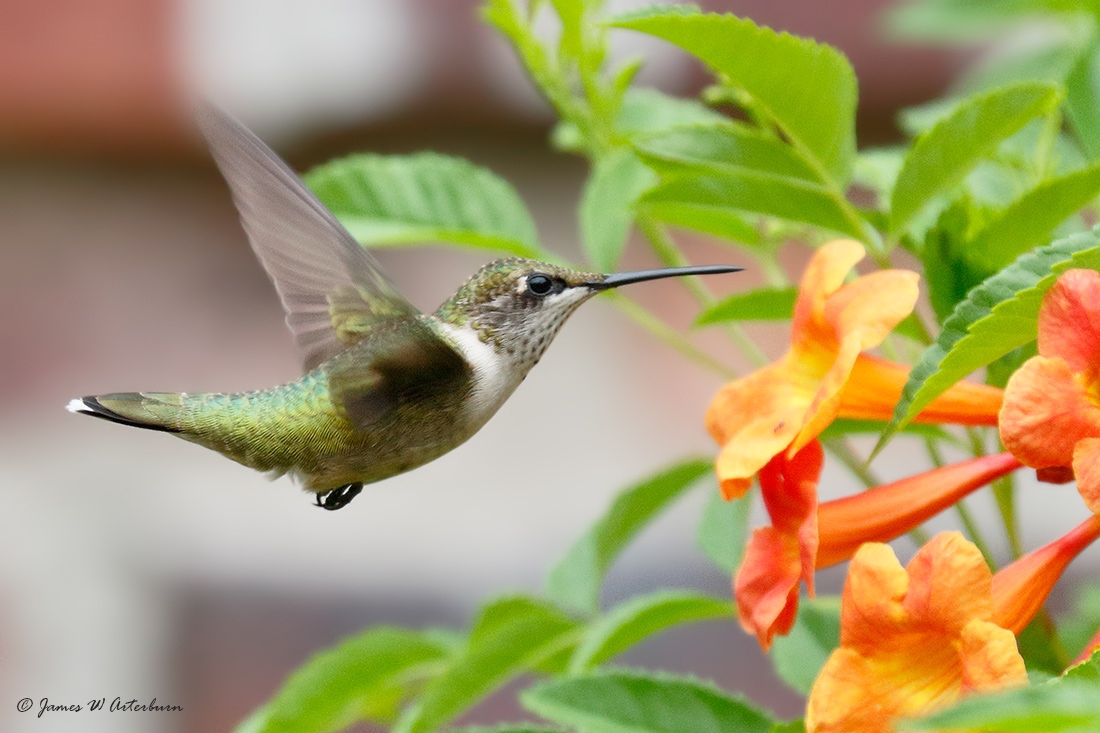
The Ruby-Throated hummingbird is a well-known and valued pollinator in America, even though its distribution is much wider. As a migratory bird, hummingbirds only spend summers in most of the US, usually spending the winter in Central America. Hummingbirds of this species may travel up to 500 miles at a time for migration.
Ruby-throated hummingbirds are two and a half to three and a half inches long, with a 3 to four inch wingspan. The bill can range from half an inch to three quarters of an inch, and is very thin, in order to draw nectar from flowering plants. Males have a shimmering, scarlet throat. Females have a lightly marked white throat, making this a sexually dimorphic species. However, the female is also distinguished by notched outer tales, marked with green, brown, and white bands. Both sexes have green metallic outer feathers on their top and creamy white feathers on the bottom (the green feathers may be more muted on the females’ heads).
Ruby-throated Hummingbirds live in woods, meadows and forest edges. They can often be found in parks and backyards. While in Central America, they’re more likely to be observed inscrubland, rather than rainforests. They will defend their food sources jealously against competition. These can also include small insects which are important protein source for newly hatched chicks and juvenile birds.
This species can beat its wings more than 50 times a second, in order to remain airborne. Because of this, they can hover and stop instantly, as well as maneuver backwards. These skills are put to good use during the courtship display. Males fly in front of their partners in a wide arc, making a buzzing noise on each pass (this motion has been described as a “pendulum”). Females usually raise their broods alone, however, with the incubation period lasting less than two weeks. The young are usually ready to fly 20 days after hatching.
Here are some additional sources:
https://www.allaboutbirds.org/guide/Ruby-throated_Hummingbird/id
https://www.audubon.org/field-guide/bird/ruby-throated-hummingbird
https://www.nationalgeographic.com/animals/birds/r/ruby-throated-hummingbird/
Featured pollinator plant: Trumpet Vine Campsis radicans
Written by: Robert Gibson, an undergraduate Environmental Studies student at the University of Oklahoma
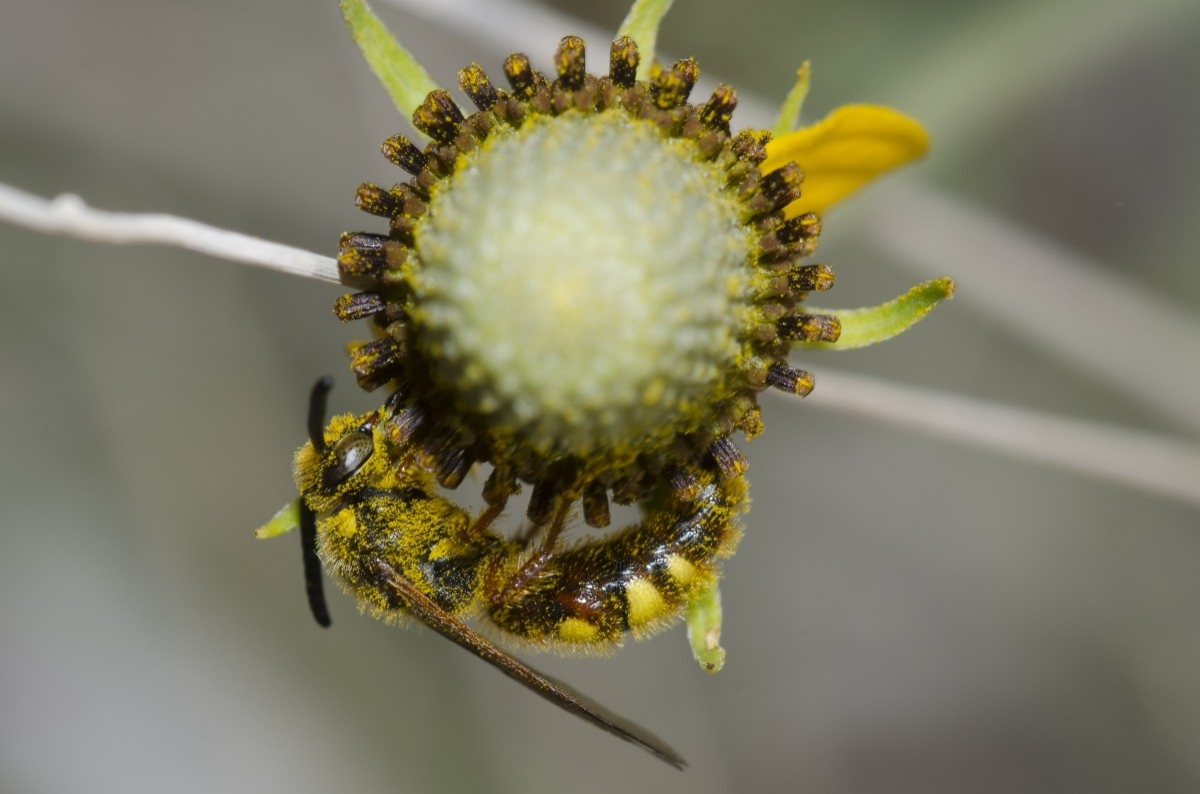
This family of wasps has earned a set of descriptive nicknames — “scarab hawks” and “scarab hunters,” because of their parasitic life cycle. Female moths search for a scarab grub (dung beetle), paralyze them with their sting and proceed to their eggs on the immature beetle. The grub is the nesting site and a food source for the larvae. The best time of year to observe this spectacle is mid-spring to the end of summer, when Scoliid wasps can be seen (and hopefully avoided) in backyards, fields, and meadows. While there, the adult wasps are usually pollinating an assortment of wildflowers.
Wasps of the Scoliid family, composing an estimated 550 species, are larger and thicker than typical wasps, making them one of the least pleasant types to encounter on a picnic (true to form, they’re also known as flower wasps or mammoth wasps). In most cases, wasps of these species are black, broken up with orange and yellow bands and stripes, which may causethem to be mistaken for bees at a distance. The rest of their visual profile greatly resembles our stereotypical depictions of wasps. Scolia range between 10-15 mm in length, with their thick bodies covered in dense fuzzy hair. The legs are patterned with hairy spokes as well. Their wings are characterized by “longitudinal wrinkles” (situated towards the apex). A rule of thumb todifferentiate the two sexes is head width. Male heads are usually wider than 3 centimeters. Female heads are less wide, most of them ranging below 3 mm. Females also have a plumper abdomen.
For more, please consult these sources:
https://bugguide.net/node/view/91
https://entnemdept.ifas.ufl.edu/creatures/misc/wasps/scoliid_wasps.htm
Written by: Robert Gibson, an undergraduate Environmental Studies student at the University of Oklahoma
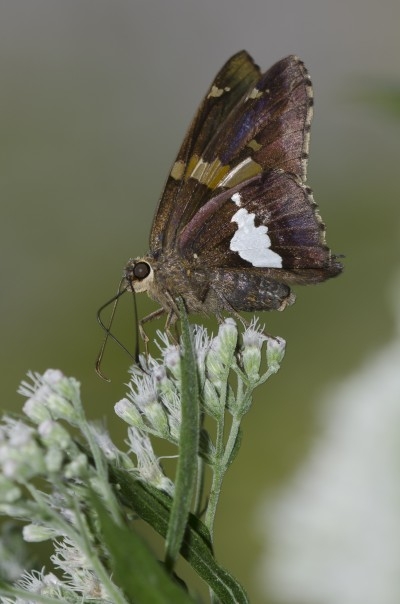
The silver-spotted butterfly is a crucial component of ecosystems due to its pollinating nature. The most recognizable feature of the silver-spotted skipper is the large white spot on the underside of each hind wing, hence the name “silver-spotted”. Their dull brown coloring is similar to that of moths, yet it is indeed a butterfly. Skippers also have stout bodies and smaller wings than other butterflies, with a wingspan of about 1¾ – 2½ inches. Their large eyes appear to bulge out from their head and their antennae is short with clubbed ends.
These butterflies can be found in the extremely southern regions of Canada and all throughout the United States, with a concentration in the eastern half. Skippers often have swift, jerky flight paths and frequent the edges of forests, swamps, brushy area, and other open areas. When not actively foraging, adult skippers often perch upside-down on the undersides of leaves. This is when they rest at night or when its cloudy. There are two broods from May to September in most of the East, a single brood to the north and west, and three to four broods from February-December in the Deep South.
Adult skippers feed on nectar from a variety of flowers, mud, and occasionally animal feces. Larvae eggs are laid in leaf shelters that are created by folding down a flap of leaf and tying it down with silk threads from the butterfly. When newly hatched, it is up to the larvae to forage to find food and eventually they leave the old shelter. The pupil stage is when overwintering occurs in a dark brown chrysalis inside the final leaf nest. Leaves of herbs, vines, shrubs, and trees in the pea family, both herbaceous and woody, provide nutrients for skippers. There is a preference for blue, red, pink, purple, and sometimes white and cream-colored flowers. They are not often found in groups, opting for a single lifestyle.
Useful resources to discover more about the silver-spotted skipper include:
https://www.butterfliesandmoths.org/species/Epargyreus-clarus
http://entnemdept.ufl.edu/creatures/bfly/silver-spotted_skipper.htm
https://bugguide.net/node/view/403
https://wimastergardener.org/article/silver-spotted-skipper-epargyreus-clarus/
Featured pollinator plant: Late-flowering Boneset Eupatorium serotinum
Written by: Christian Newkirk, an undergraduate Environmental Science student at the University of Oklahoma
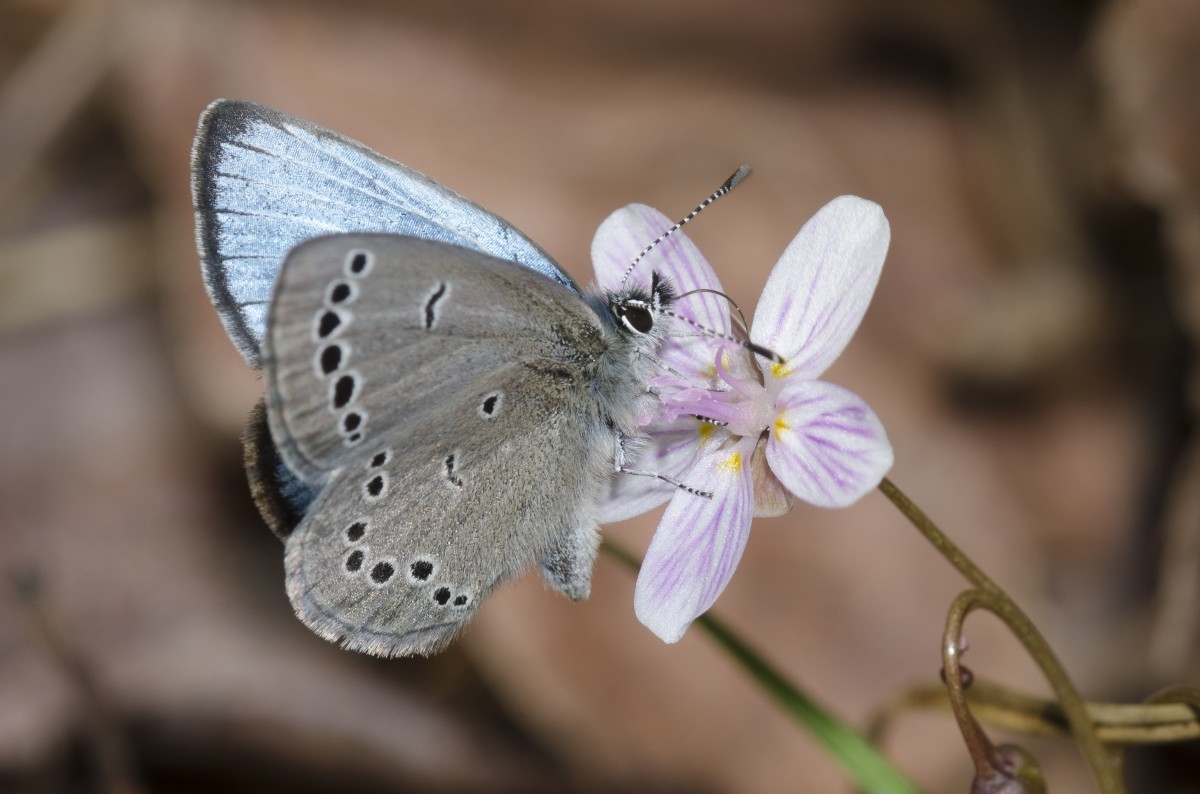
The Silvery Blue Butterfly is known for its silvery blue wings. Males have narrow dark borders, where the females have wider borders. The underside of them are a gray-brown, and their wingspan is 7/8 – 1 1/4 inches. The blue on the females and the size of their black dots vary, but both sexes have white fringe. They live in many locations, from open woods to the side of the road and can be found all the way from Central Alaska south to southern California, to western Kansas and along northern United States east to Nova Scotia and south to Georgia. A Silvery Blue Butterfly can exist happily from open woodland, flowery meadows, and sometimes in small waste areas in cities.
When searching for a mate, males actively fly around the host plants in search for a female. Their eggs are laid on the flower bud and young leaves so that the new larvae can eat the emerging flowers. Often a single plant, or leaflet, hosts several eggs. Larvae are Lycaenid in shape and are tended to by the ants in the area. Coloring varies by habitat, foodplant, and subspecies. Pupas are covered by debris or transported to ant nests on the ground during pupation. Hibernation occurs as a pupa.
There is a single brood that flies from March to June at low elevations, and from June-August at high elevations. A particular flower that provides nectar to the adults is the Asteraceae, however they feed on many legumes. Local populations specialize to the local plant life.
Useful resources to discover more about Silvery Blue Butterfly and how to protect them include:
https://www.butterfliesandmoths.org/species/Glaucopsyche-lygdamus
http://butterfly.ucdavis.edu/butterfly/Glaucopsyche/lygdamus
http://www.learnaboutbutterflies.com/North%20America%20-%20Glaucopsyche%20lygdamus.htm
http://www.cbif.gc.ca/eng/species-bank/butterflies-of-canada/silvery-blue/?id=1370403265767
Featured pollinator plant: Spring Beauty Claytonia lanceolata
Written by: Christian Newkirk, an undergraduate Environmental Science student at the University of Oklahoma
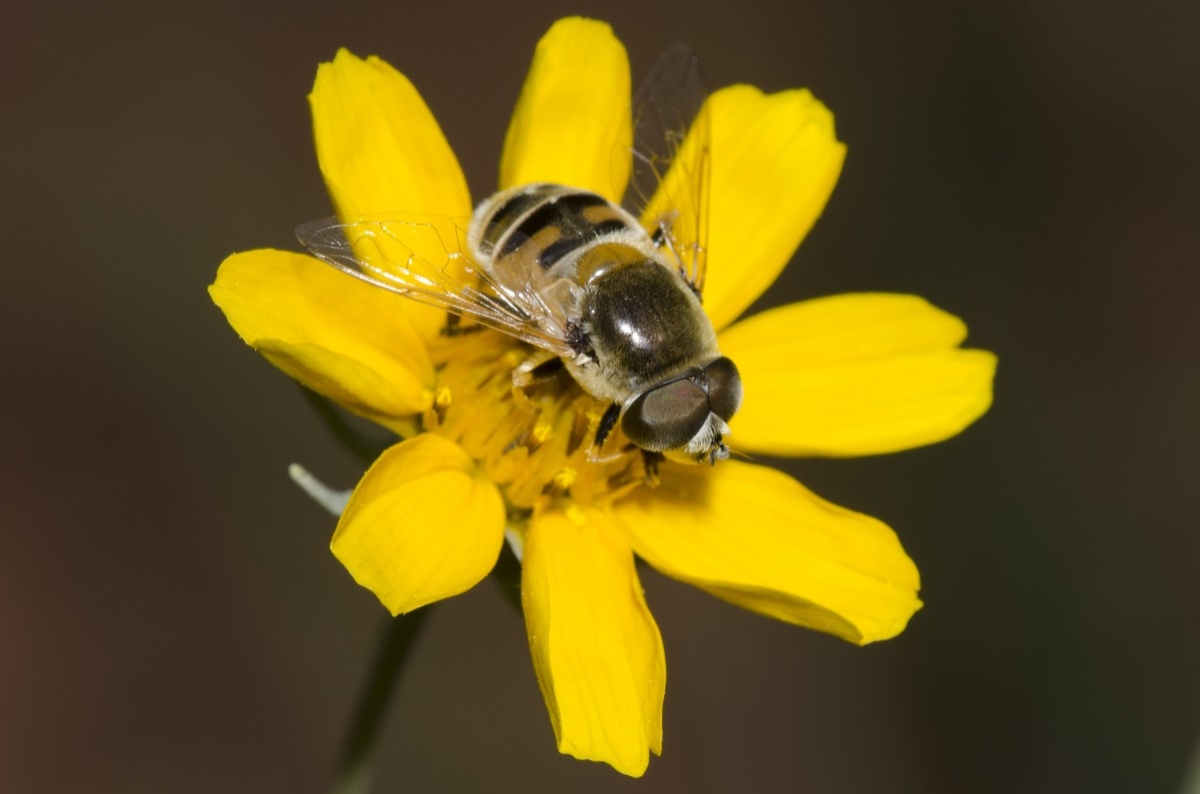
The term “Syrphid fly” applies to a great many flies and not a single species, composing the insect family, Syrphidae. This family can be broken down into 3 subfamilies which encompass 3,000 species. This family is also known as “hoverflies” or flower flies, which speaksto their fondness for nectar and pollinating capabilities. The adults have a simple diet of pollen and nectar, while the larvae have a diverse diet. Larvae may consume decayed or decomposingplant and animal matter (wet wood, rotting plants) or on insects themselves. Females may lay up to 100 eggs in a single brood. In most cases, the site will be chosen because of its proximity to a soft-bodied insect population, such as aphids. The number of eggs laid is greatly dependenton the presence of prey.
There are few characteristics that all species of this family share—depending on the species, the morphology of the fly can either be slender or stout. Syrphidae are usually covered in bright yellow and black hair. Spots and stripes are not uncommon. Larvae are either creamy white or green. Members of this family have a single pair of functional wings, while a smaller setfurther down the thorax and abdomen helps them maintain their balance. Typically, this family ranges between 10 and 20 millimeters long.
This family is so common it can be found worldwide, and certainly in North America, where it is recognized as a deterrent to aphid populations, which damage crops. Therefore, Syrphid flies are prized in agriculture. To attract this family, plant a diversity of flowering plants. Syrphidae favor flowers such as asters, daisies, marigolds, sunflowers, and zinnias, among others. In order to accomplish their pollination and nectar-gathering, Syrphidae have a unique flight pattern. They are known to hover, and then suddenly fly to a new position. While frequenting flowers, this family can easily be mistaken for bees. Syrphidae are also distinct frombee flies because their proboscis is not as long or prominent. Neither are their legs. Their faces also have noticeable bumps. This family also exhibits unique wing venation.
For more, check out these sources:
https://cedarcirclefarm.org/tips/entry/good-bug-syrphid-fly-or-hover-fly
https://content.ces.ncsu.edu/syrphid-flies
https://www.fs.fed.us/wildflowers/pollinators/pollinator-of-the-month/syrphid-fly.shtml
https://texasinsects.tamu.edu/syrphid-fly/
Featured pollinator plant: Engelmann’s Daisy Engelmannia peristenia
Written by: Robert Gibson, an undergraduate Environmental Studies student at the University of Oklahoma
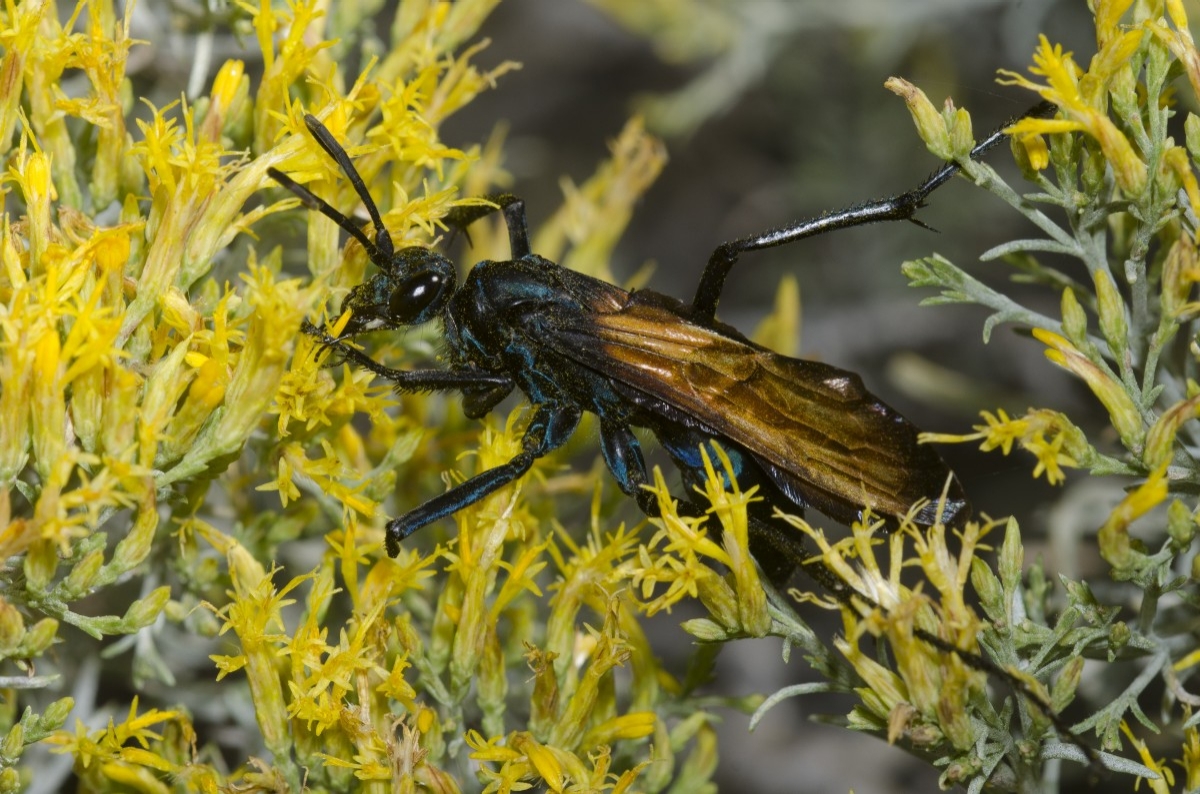
Tarantula wasps are categorized as spider wasps, named for their propensity to hunt and parasitize tarantulas. Tarantula hawks exhibit have black bodies with rusty, ochre-colored wings. In a certain light, they may appear blue-black or purple, with red wings. Tarantula hawks are some of the largest wasps recorded — measuring 5 centimeters, on average (in extreme cases, wasps have been measured at 11 centimeters). Their legs have hooked barbs for snagging onto prey. The average stinger length has been measured at 7 millimeters (⅓ inch), and rated as one of the most painful stings in the world. The sting is used to paralyze preyfor parasitizing, typically as food for the larvae.Interestingly, the size of the host spider that the wasp’s eggs will parasitize affects the size of the adult wasp.
Wasps of this species can be observed during the typical months of the pollinator life cycle— late spring through late summer— in fields, meadows, yards, and human structures (for example, barns). However, mating occurs on high ridges or tree branches.
Tarantula hawks are found throughout the southwest, ranging as far north as the California-Oregon border. Where tarantulas are, this species will be found. In addition to being nectar feeders, these wasps may also drink fruit juice. Despite a fearsome reputation, these wasps are not aggressive, refraining from a sting unless provoked or unless you are a tarantula.Tarantula wasps have been known to fly in a wide radius and search their surroundings extensively. This bold behavior is attributed to their lack of natural predators.
For more research, take a look at these sources:
https://www.nps.gov/articles/tarantula-hawk.htm
https://www.sciencefriday.com/articles/why-you-dont-want-to-get-stung-by-a-tarantula-hawk/
https://www.wired.com/2015/07/absurd-creature-of-the-week-tarantula-hawk/
Featured pollinator plant: Rubber Rabbitbrush Ericameria nauseosa
Written by: Robert Gibson, an undergraduate Environmental Studies student at the University of Oklahoma
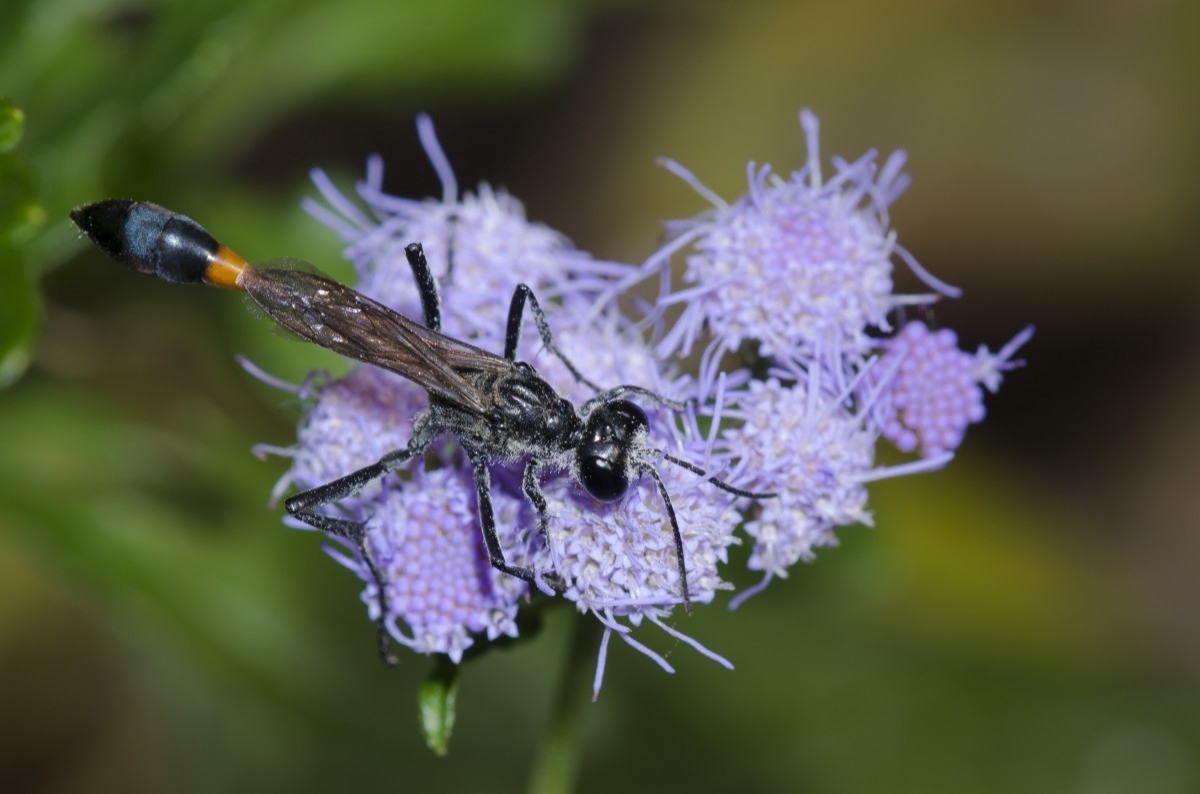
The Thread-waisted Wasp can be anywhere from 10mm long to 30mm long. They appear long and stalked, creating a “thread-waisted” look. Their bodies have middle tibiae with two apical spurs and could be all black, black and red, yellow and black, or white and black, with markings on their abdomen. Thread-waisted Wasps are generally solitary nesters that inhabit much of the world and can build ground or aerial nests out of mud. Though they are nonsocial, some are klepto-parasitic and use prey that was caught by another wasp to provide for their own larvae.
Larvae of this species feed on the paralyzed arthropods that host this species, such as spiders, grasshoppers, and caterpillars. These hosts can be stored in the nests, ready to be eaten by the larvae. Malaxation, the crushing of the neck by the wasp’s jaws, often afflicts the host as well as a paralyzing sting. Eggs are laid on the host body. The adults feed on the nectar they get from flowers and extrafloral nectaries, honeydew, and body fluids of their prey
For more information check out the following websites:
https://www.insects.orkin.com/entophiles/hymenoptera/thread-waisted-wasp-ammophila-spp/
https://ucanr.edu/blogs/blogcore/postdetail.cfm?postnum=24702
https://www.britannica.com/animal/thread-waisted-wasp
https://bugguide.net/node/view/135
Featured pollinator plant: Blue Mistflower Conoclinium coelestinum
Written by: Christian Newkirk, an undergraduate Environmental Science student at the University of Oklahoma
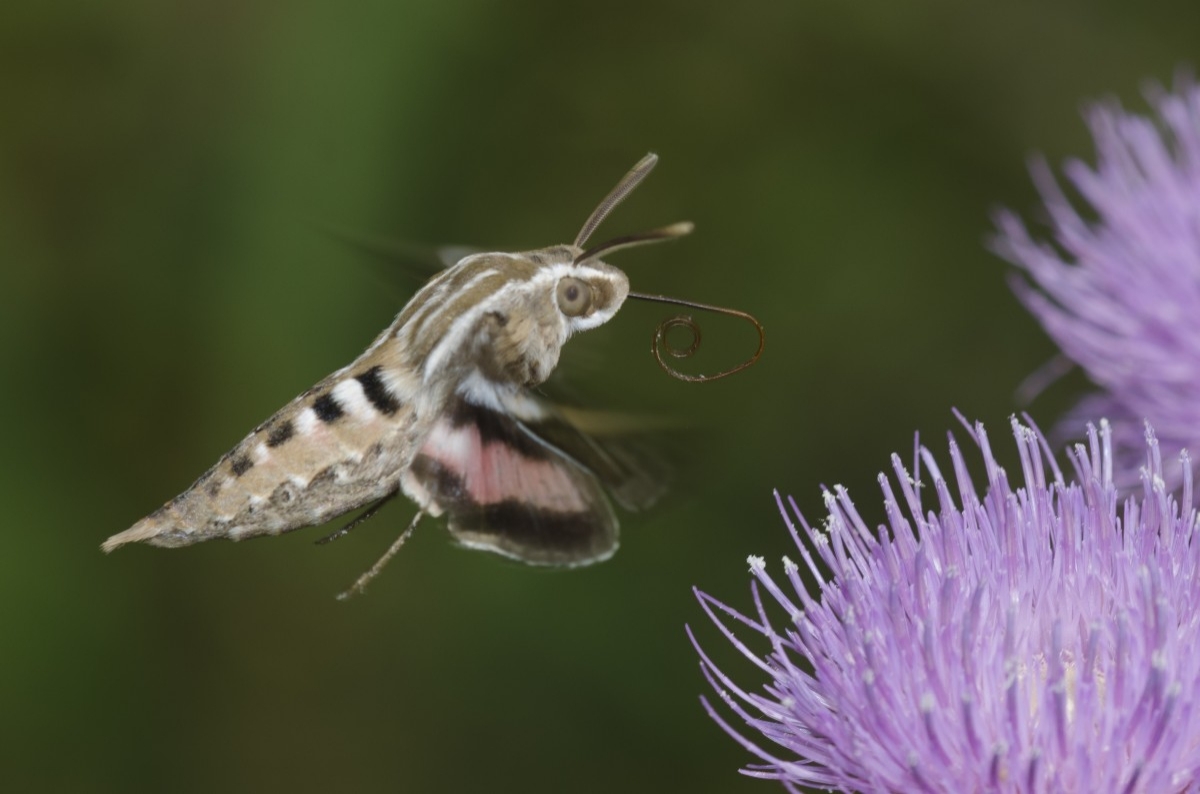
Usually when moths are mentioned, the first thought is about the small white creatures that flutter into lightbulbs at night. For the White-Lined Sphinx Moth, this description does not hold true. With an adult wingspan of 2-3 inches and a diet consisting of plant nectar, this moth has earned its nickname of “The Hummingbird Moth.” The adults of this species are easily identifiable due to a fairly consistent coloration of brown forewings with thick white lines running from the body to the tip of the wing. They also showcase distinct flashes of pink on their hind wings, as well as being extremely hairy. The caterpillars however, come in a wider variety of colors spanning from light green to purple to black, but can be identified in their full-grown larval form by their distinct horn. The larvae of this moth are typically hosted by apple trees, fuchsia, grape, and primrose but due to the wide range of this pollinator, a robust list of dietary plants would be too long and dependent on geography.
The adult of this species has been known to feed on and pollinate a large variety of flower nectar. Typically, their diet depends on what time of the day the moth is active as the White-Lined Sphinx Moth is known to be both nocturnal and diurnal dependent on the location and time of year. Typically, the moth will prefer more fragrant flowers like honeysuckle and primrose. Diurnal moths will primarily harvest nectar from brightly colored flowers, but nocturnal ones will prefer to drink from the white and gray flowers that offer more contrast against the darkness. When feeding, they heavily resemble hummingbirds due to their long proboscis and fuzzy hovering body, and they fulfill a similar role during pollination.
As a pollinator, this species is inconsistently helpful in the proliferation of plants. Studies have shown that hyles lineata has a variable tongue length among individuals, and due to their feeding habits, this changes their effectiveness in pollination. Individuals with relatively short tongues often get covered in pollen when they feed, which allows for pollination to occur when the moth goes to another flower. Longer tongue individuals do not collect pollen in the same way, and are capable of taking nectar from a flower without pollinating the plant.
To find more information and studies about this incredible species, please use these helpful resources.
https://www.insectidentification.org/insect-description.asp?identification=White-lined-Sphinx-Moth
https://wimastergardener.org/article/white-lined-sphinx-moth-hyles-lineata/
https://onlinelibrary.wiley.com/doi/abs/10.1111/j.1558-5646.1981.tb04936.x
Featured pollinator plant: Tall Thistle Cirsium altissimum
Written by: Joshua Hughes, an undergraduate Aerospace Engineering student at the University of Oklahoma

Formica ant workers can be from 4mm to 8mm in length and some are weakly polymorphic, being red or black. The alates, ants with wings, are larger, being 5mm to 13mm. The queen is typically 12-15mm, she is dark red and black, and mostly polygyn (multiple queens per colony). The workers have conspicuous ocelli, double row of bristles on flexor (ventral) surface of middle and hind tibiae, mesosoma with “bumpy” (stair-stepped) profile, dorsal surface of propodeal profile as long or longer than the posterior, declivitous face. They can make their homes in the northern hemisphere, from warm temperate to subarctic zones, and can be found across southern Britain, North to Mid Europe, Pyrenees and Siberia
Formica ant can be known as wood, forest, field, or mound ants depending on the habitat and nesting preferences for the various species with there being over 200 different species. Open woodlands, forests, and grasslands are a favorite. Nests can be built in rotten wood or soil and can be elevated as a mound made from earth and pieces of plant, such as pine needles. Ant nests can reach a few meters high. These ants are active from spring till frost and mating occurs in late June through early August.
Formica ants will attack and kill arthropods, sometimes earthworms, and often seek honeydew and extrafloral nectar, often foraging high in trees to gather these sweets. Worker ants can forage up to 50 meters away from their nest.
For more information check out the following websites:
https://bugguide.net/node/view/16569
https://antark.net/ant-species/wood-ant-formica-rufa/
https://www.insectidentification.org/insect-description.asp?identification=Formica-Ant
Featured pollinator plant: Green Milkweed Asclepias viridis
Written by: Christian Newkirk, an undergraduate Environmental Science student at the University of Oklahoma
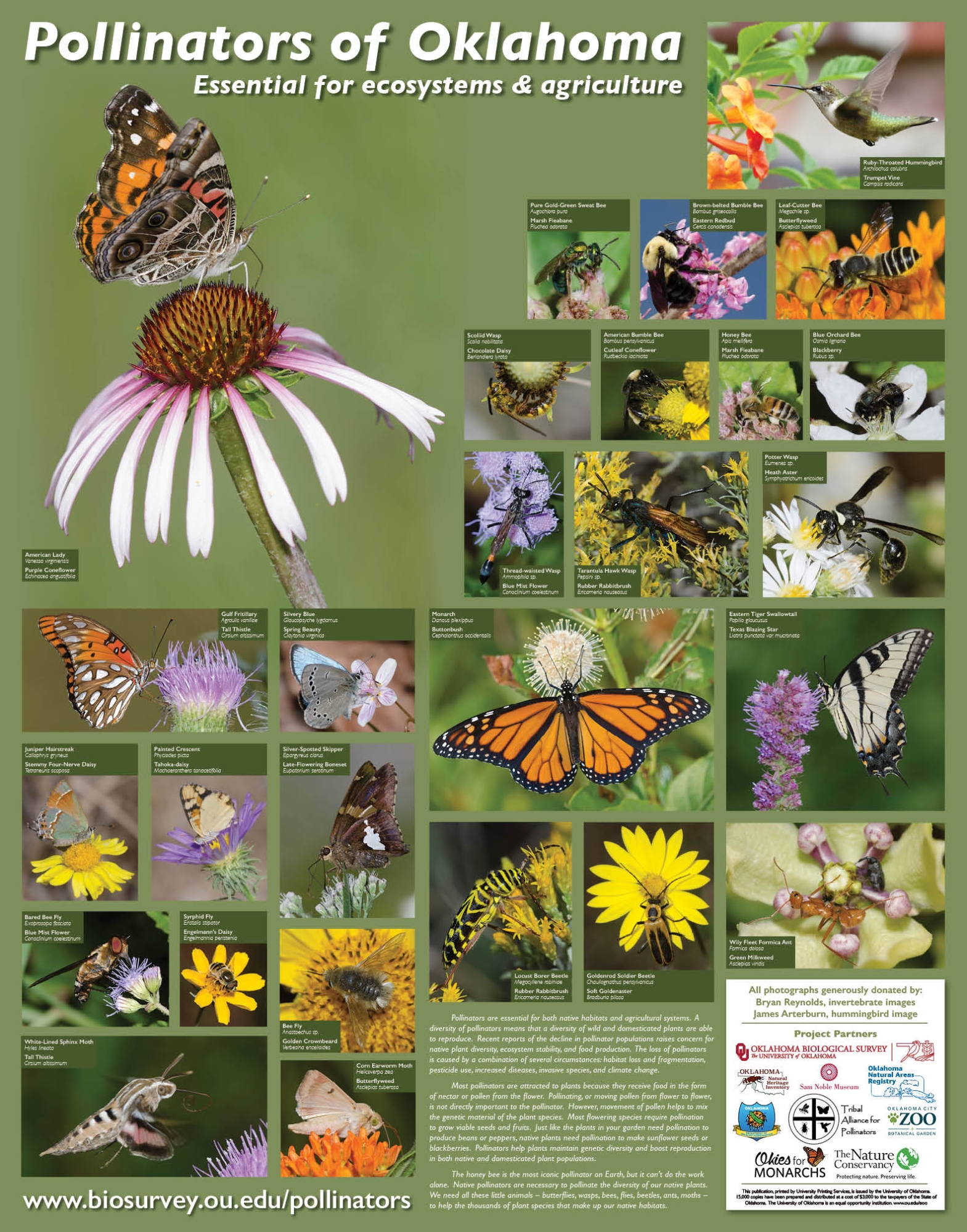
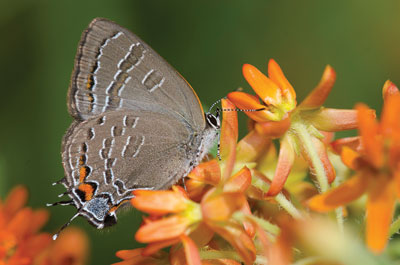
About 75% of all flowering plant species need the help of animals to move their heavy pollen grains from plant to plant for fertilization.
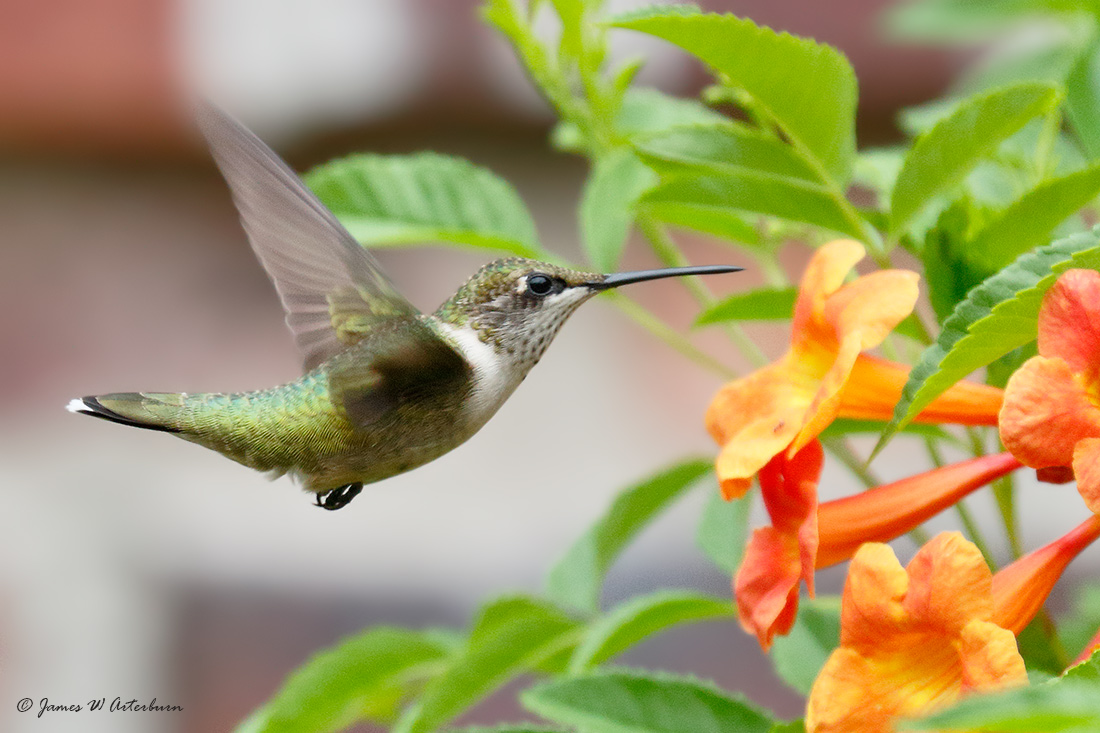
About 1,000 of all pollinators are vertebrates such as birds, bats, and small mammals.
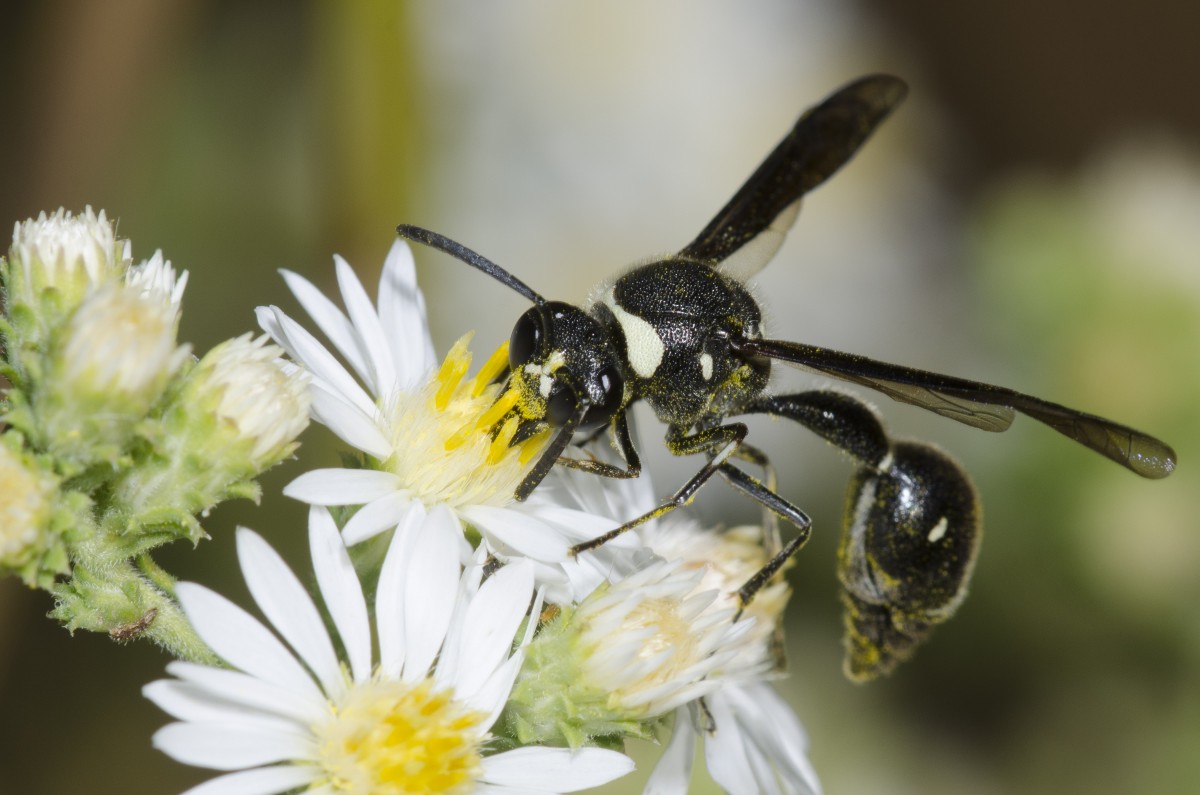
Most pollinators (about 200,000 species) are beneficial insects such as flies, beetles, wasps, ants, butterflies, moths, and bees.